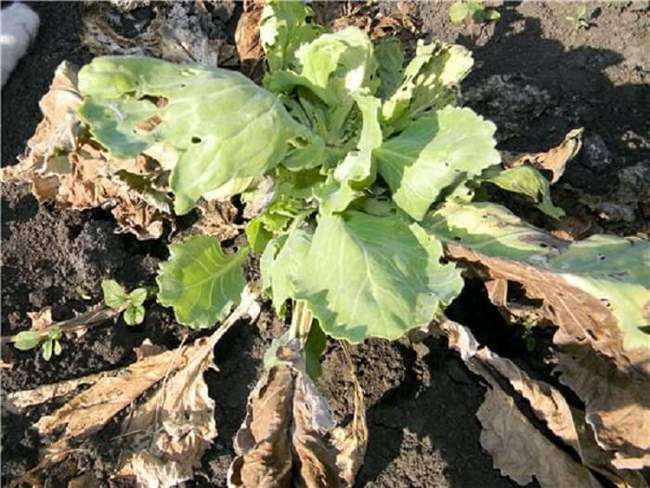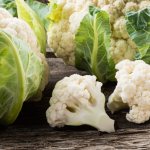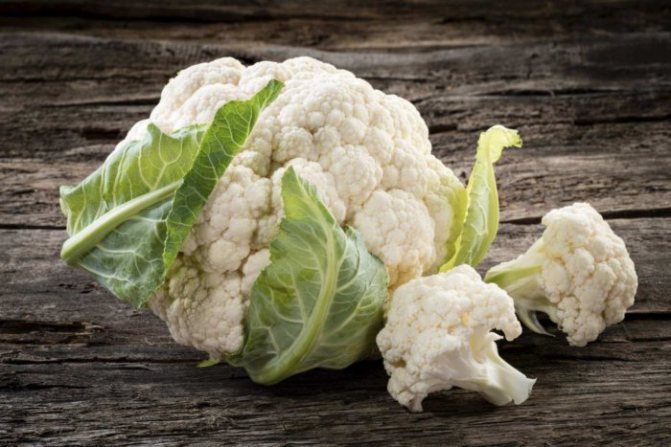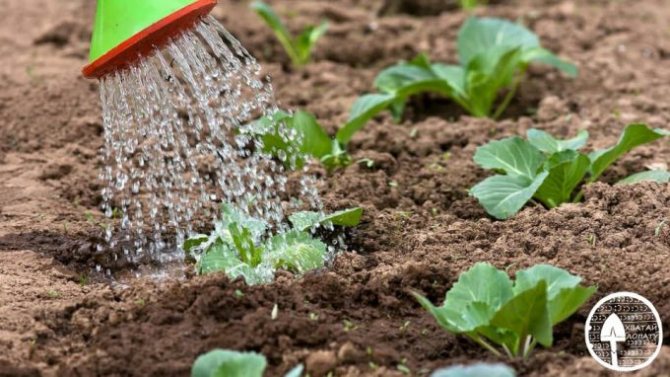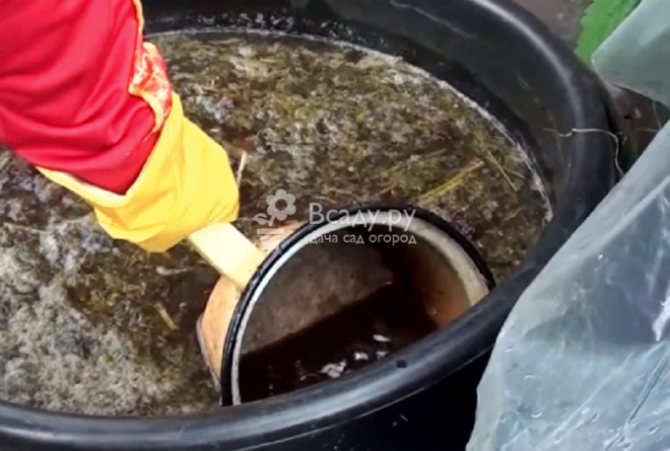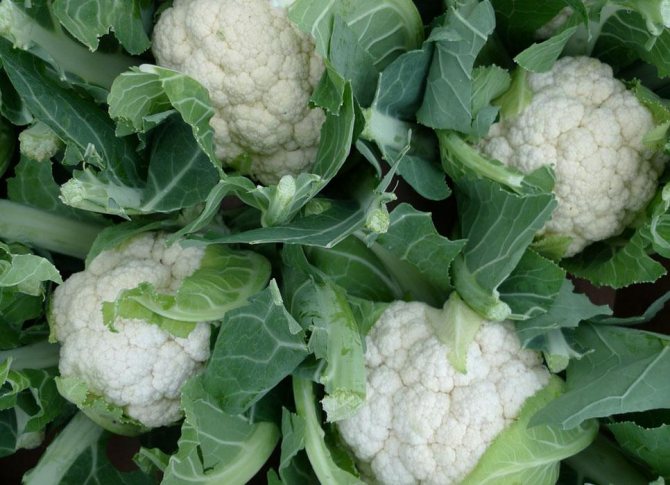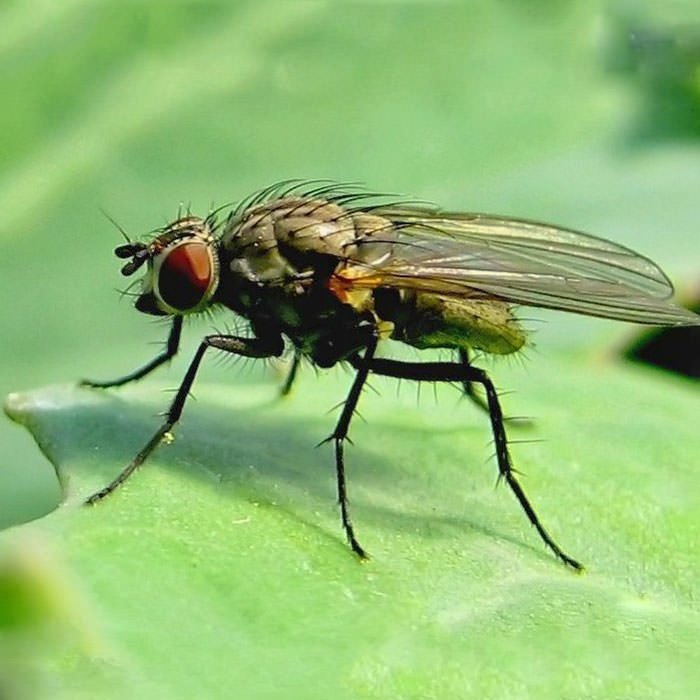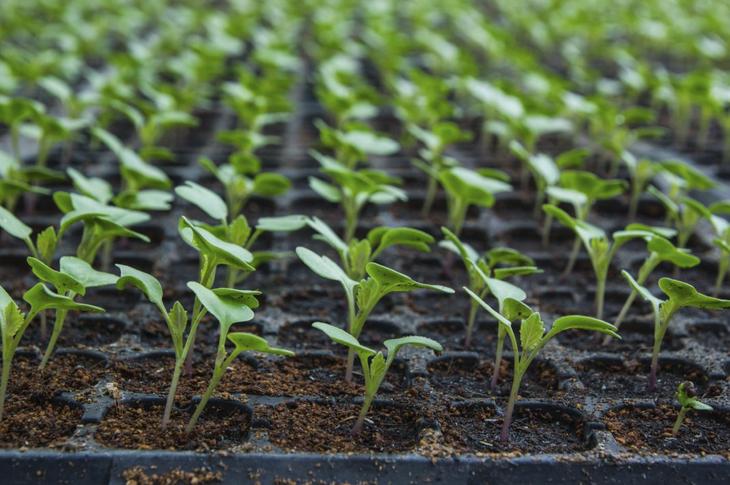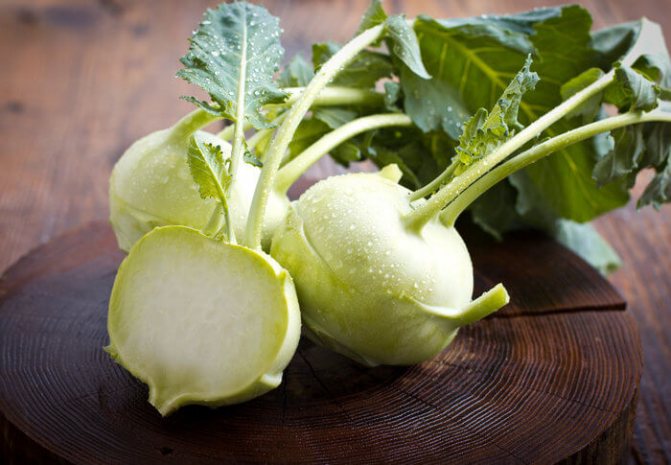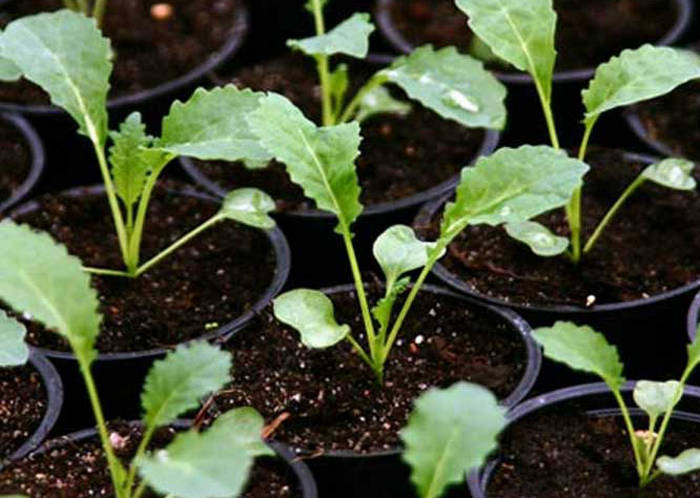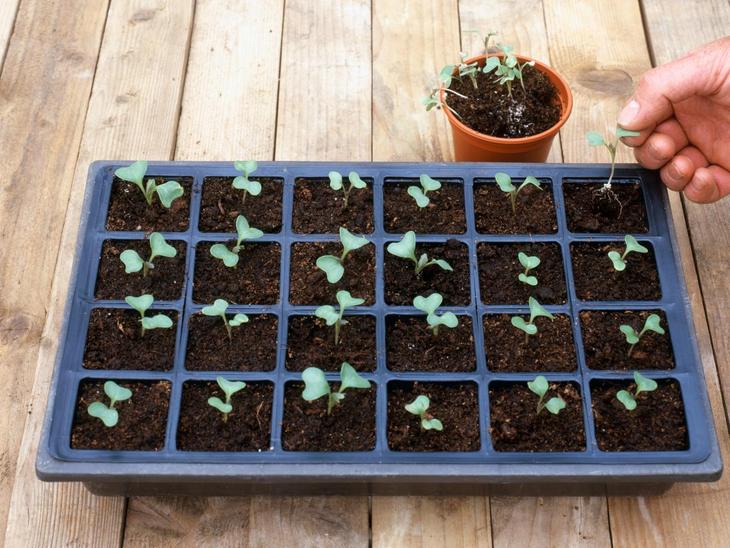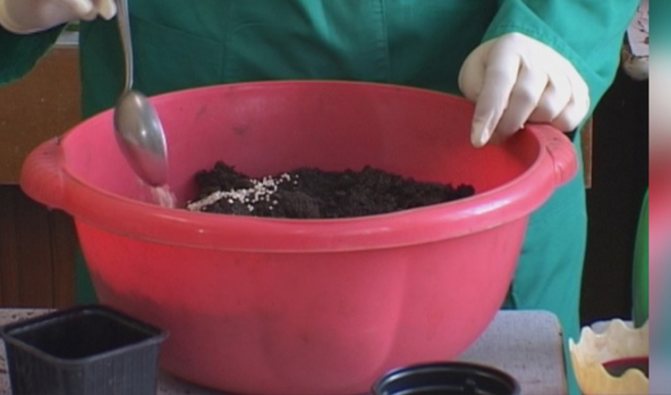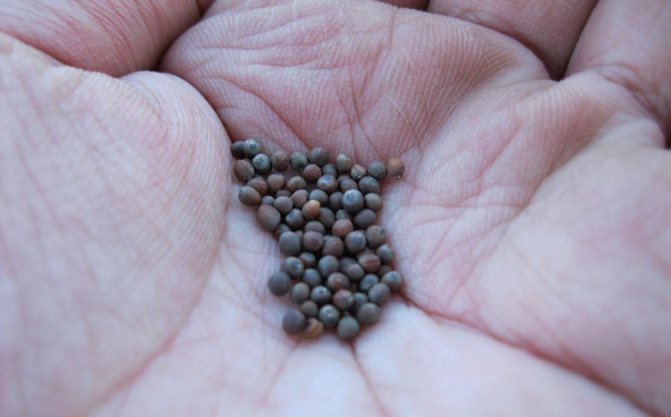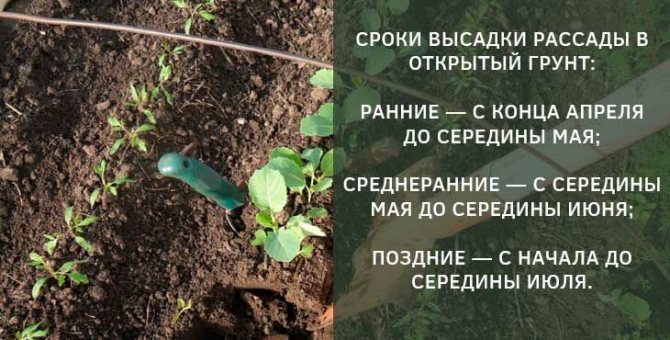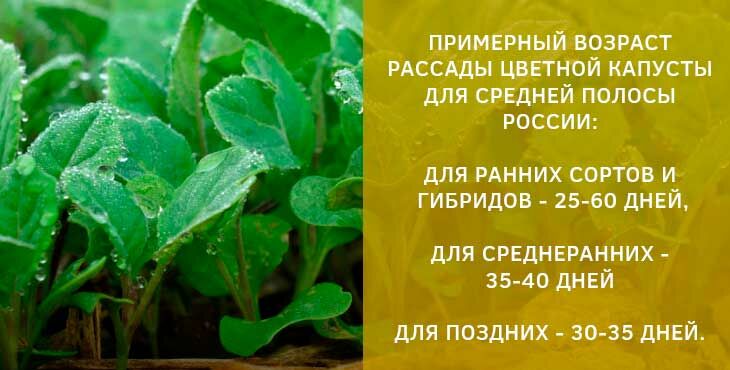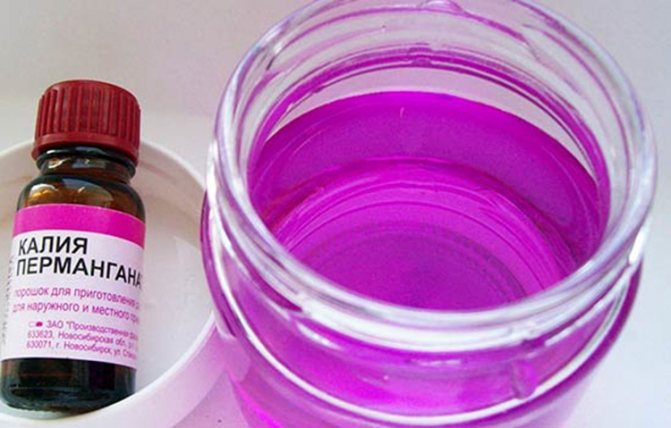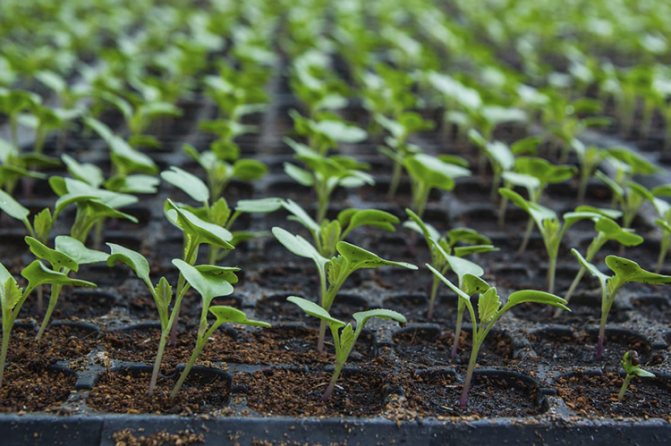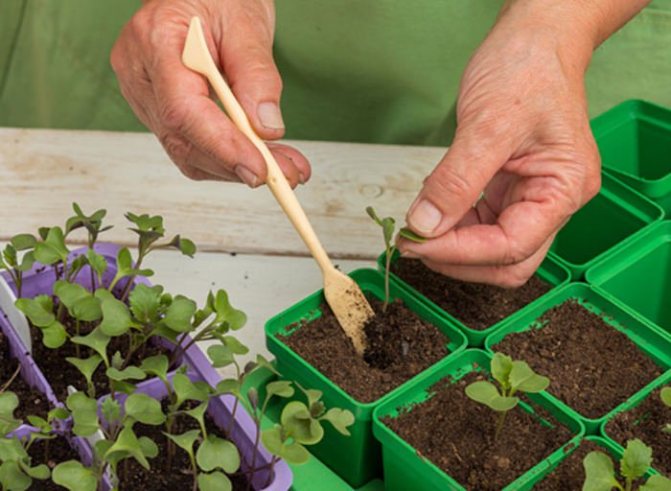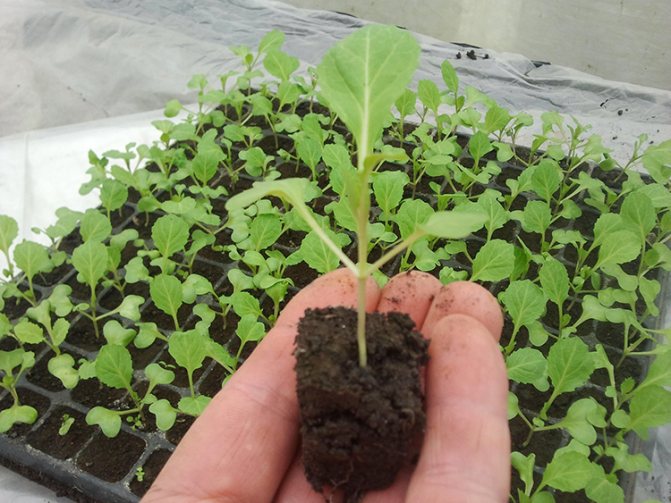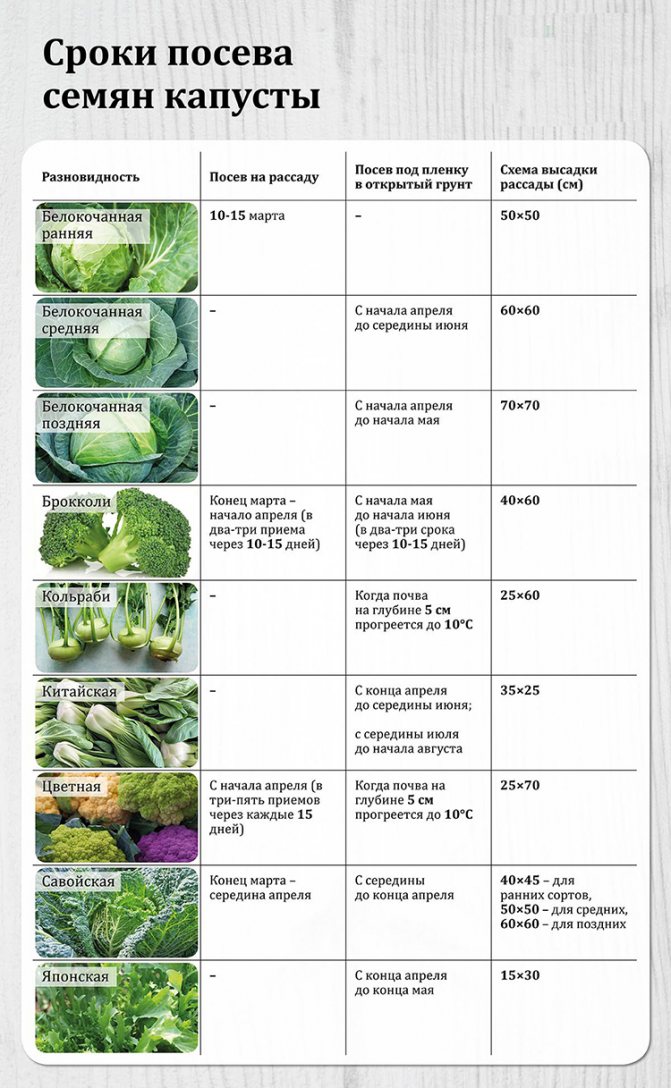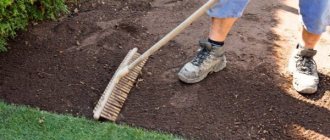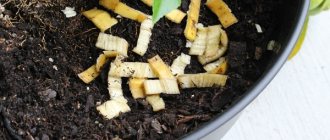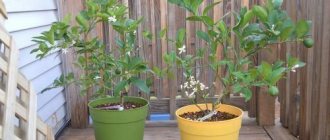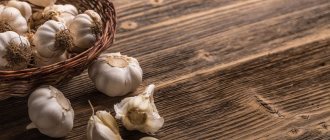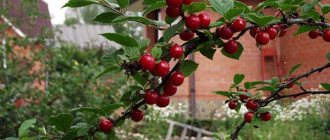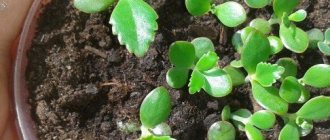Cauliflower is prone to overgrowth, so you need to know the approximate maturation time of the heads. A delay in harvesting for several days can lead to a loss of the crop and a decrease in its quality.
The harvest period for this crop depends on many factors. It is influenced by illumination, temperature conditions, and the quality of care. The defining moment is the varietal characteristic - the ripening period.
Site preparation
Cauliflower is planted on pre-prepared beds, while agricultural technology must comply with certain rules. In the fall, after the main crop has been harvested, the soil begins to be prepared for spring sowing. To do this, it is loosened, removing weeds and insect larvae. After about two weeks, fertilizers are applied to it - 5 kg of organic, 30 g of potash and phosphorus fertilizers are consumed per square meter. After fertilizing, the garden bed is dug onto a shovel bayonet and left to rest until spring.
With the onset of warmth, the soil is loosened and urea is added - about 20 g per square meter. Do not forget: planting cauliflower is done in dense soil, that is, you do not need to re-dig it. If you did not have time to dig up the earth in the fall, then you will have to do it in the spring, but then before planting it will have to be compacted, slightly tamped. This affects the quality of the heads: compliance with this rule is necessary for them to be dense and tasty.
Prevention and treatment of diseases
They remain without a crop due to Alternaria, black leg, mucous bacteriosis, viral mosaic. In order to prevent diseases, crop rotation is observed, in the fall they clear the soil of weeds and plant residues, and sow siderates.
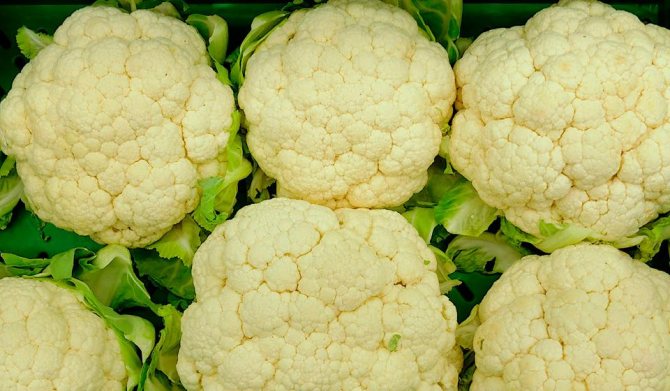
In the summer, fungicides are used for prevention and treatment:
- Alirin-B;
- "Gaupsin";
- "Gamair";
- "Trichopol";
- Fitosporin.
Cauliflower is treated with fungicides every 10-12 days.
Insect protection
Cauliflower is loved by butterfly caterpillars, cabbage moth, whitefish. They are gnawed by snails and slugs. Landings suffer from aphids and cabbage fly larvae. For the prevention of garden pests, cauliflower is treated with bioinsecticides:
- "Verticillin";
- "Bicol";
- "Bitoxibacillin";
- Boverin.
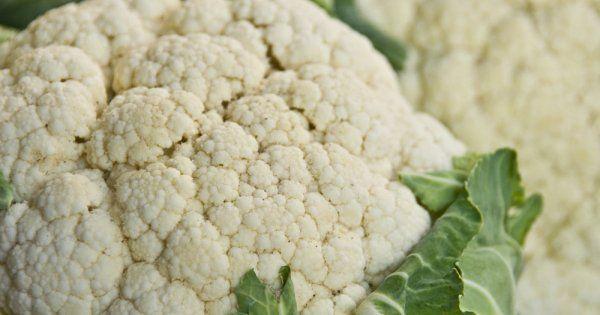

These drugs are used in tank mixes. Treatments are carried out during the summer of insects and the appearance of larvae. From slugs and snails, cabbage beds are sprinkled with ash. Lay out bait from watermelon peels and damp rags dipped in kvass.
Planting methods
Planting cauliflower is most often done in seedlings. However, today gardeners often resort to open sowing of seeds in the ground. Do not forget that the ripening of the heads occurs quickly enough, and in order to harvest throughout the summer, sowing seeds can be done in 3-4 terms with a break of 20 days. For the earliest planting, seedlings are grown in hotbeds and greenhouses, and summer and autumn crops are made directly into the ground. Do not forget that when the air temperature drops, the seedlings must be protected with a film.
There are a huge number of varieties on the market today. Early maturing plants are perfect for growing in greenhouses. Until recently, good cauliflower was grown only in the south, but today it is available everywhere.But even in a greenhouse, if the weather is too cool, the heads can grow smaller than usual. Mid-season cauliflower works best. Planting seedlings will allow you to harvest an early crop, and sowing in a garden will also allow you to harvest a second and third. Late varieties usually do not mature in cool climates.
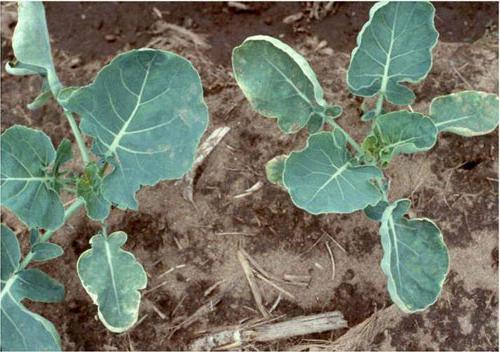

Answers to frequently asked questions
Why the head is not tied up is the most pressing question of novice gardeners. Perhaps the reason is the hot weather. In the heat, inflorescence does not form. Violation of planting dates is another reason for a poor harvest.
| Planting method | Sowing | Transfer to the ground |
| Seedlings in the apartment | March 15-20 | End of April, beginning of May |
| Seedlings in a greenhouse, greenhouse | First decade of April | When forming the 4th sheet |
| Seed in the ground | April June | – |
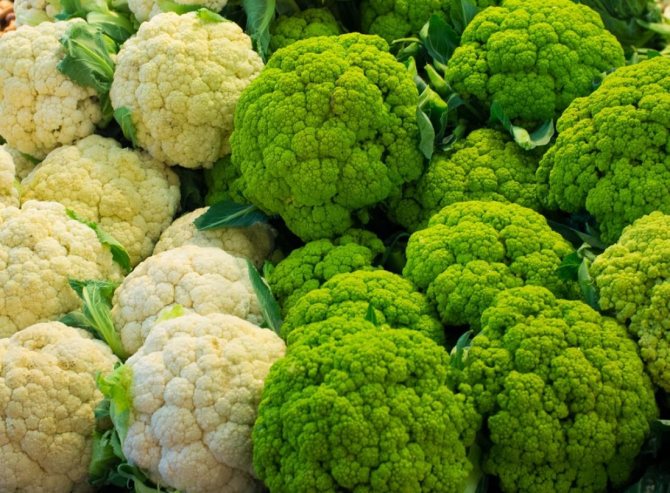

Do I need to pick off the lower leaves?
In this matter, you need to listen to the opinion of experts. They believe that this operation is harmful to the cauliflower:
- infection (viruses, fungi) can get from the ground into the wounds, infected heads of cabbage are poorly stored;
- the lower leaves nourish the head, their removal will affect its size;
- the juice released from the wound will attract pests, this will affect the quality and size of the inflorescence;
- the earth dries faster, you have to water more often.
You can pick off dry and decaying leaves. There is no benefit from them. Sprinkle the wounds and soil with ash. This will protect the cabbage from infection.
Is it possible to get a second harvest?
Two crops from one root are obtained in the south... It won't work in Siberia. Summer is too short. In the Kuban and Stavropol Territory, they manage to get 3 heads from one root. The leaves and inflorescence are cut off, the stump is not touched. It is huddled, watered, fed with mullein solution. After a few days, young shoots appear (1-2 pcs.). New inflorescences are formed on them. They are smaller than the first, but they are good for food.
Growing a good harvest of cauliflower is not easy. The culture is very sensitive to high temperatures, requires a balanced diet, and loves fertile soil. A slight delay in harvesting will reduce the quality of the crop.
Sowing seeds
The first task is to grow an early harvest for summer salads, in which cauliflower fits perfectly. Planting seedlings is carried out in accordance with the following rule. To get friendly shoots and healthy seedlings, you need to select only large seeds. Before sowing, the following procedure is performed: the seeds are wrapped in a cloth and dipped in hot water. You should not heat it to a boil, the best option is 50 degrees. Now the activated seeds are cooled in cold water and soaked in a solution of potassium permanganate for 8 hours.
This preparation provides excellent germination. Seeds ready for planting are sown in special boxes. The soil can be any, but a mixture of peat and humus has proven itself best. In addition, 15 g of superphosphate and potassium sulfate must be added to a bucket of soil mixture. In practice, cauliflower is planted with seeds in open ground. On slightly moistened and compacted soil, grooves are marked with a depth of 0.5 mm, into which the seeds are laid. They are covered with the same mixture and lightly covered with earth.
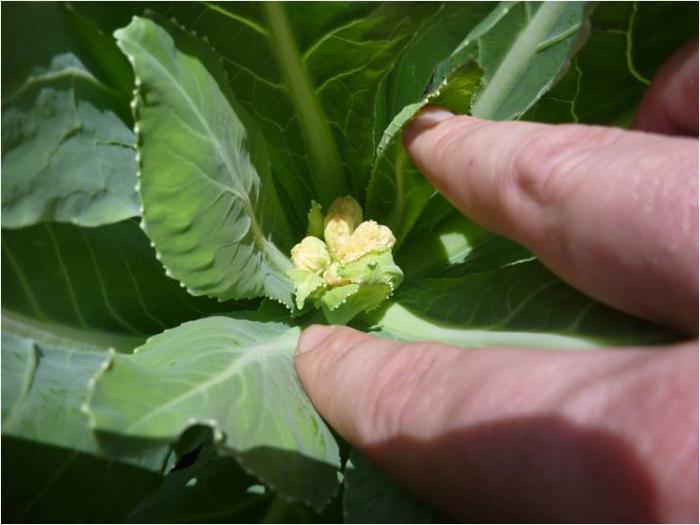

Storage features
Cut heads are not exposed to light. The harvest is stored up to 60 days in the presence of a cellar (room), where the air temperature is not higher than 2 ° C, and the humidity is about 90-95%. The inflorescences are kept in plastic containers, tightened with cling film or suspended by stubs.
For a month or a little less, the heads lie in the refrigerator without losing consumer qualities. So that they do not fade, ahead of their time:
- wrapped in several layers of paper (newspaper);
- put in a food bag;
- wrapped in cling film.
For city dwellers, the best place to store cauliflower is the freezer.The harvest is safely stored in it all winter. The time spent on preparing cabbage for storage is compensated in the future. Any dish made from frozen cauliflower blossoms cooks very quickly.
On a note! According to gardeners' reviews, Baldo F1 is ideal for storage - an excellent hybrid with white commercial heads weighing up to 2 kg, with a diameter of about 20 cm.
The process of preparing inflorescences for freezing is simple:
- After cutting, the head of cabbage is soaked in a large volume of water for 30-60 minutes. If there were insects on it, they will float up.
- The head is disassembled into inflorescences, washed with a colander in running, cold water.
- Boil water in a large saucepan, add some salt to it, blanch the inflorescences.
- The cabbage is poured over with cold water, dried, laid out on trays for freezing, and sent to the chamber.
- Frozen inflorescences are poured into bags, packed, set the date of packing, sent to the freezer.
Conditions of detention
The optimum temperature for cabbage is +20 degrees. Under these conditions, seedlings will appear in about 4-5 days. The main danger lurks here: cabbage tends to stretch out quickly, therefore, immediately after the emergence of shoots, the air temperature is reduced to +6 degrees. After about 5 days, it is raised to 15 degrees - this helps to get acclimatized. This is easiest if your seedlings are in pots, but planting cauliflower seeds outdoors leaves room for maneuver. The film covering the greenhouse is removed or opened from one edge. This way the temperature is regulated.
Features of growing in the regions
Cauliflower is thermophilic. In the southern regions, it is able to give 2-3 harvests per season, and in the middle lane and further north it is not so easy to get even one. Therefore, when choosing varieties, you need to pay attention to those intended specifically for this region.
Moscow suburbs
In a heated greenhouse, sowing seeds for seedlings begins in the third decade of March. If the apartment has a glazed loggia, then it is recommended to plant seedlings on it from April 20. It is necessary to plant seeds at a distance of at least 4 cm, otherwise all plantings may be affected by a black leg. Prevention - no overflow, especially at low temperatures.
For growing in the Moscow region in the open field, early varieties are suitable:
- Snow globe - early, fruit weight up to 800 g;
- Express - ripening period - 55-60 days;
- Flora Blanca - white-yellowish heads, weighing up to 1 kg;
- Early ripening - ripens after 65 days.
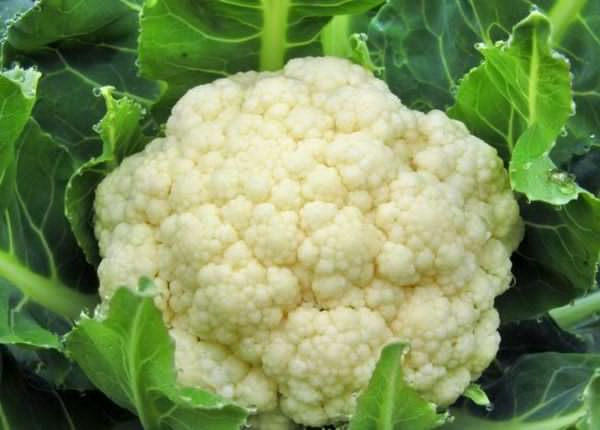

Flora Blanca cauliflower tastes great
You can sow in the greenhouse:
- Express - 55-60 days from the moment of disembarkation of seedlings to the receipt of fruits;
- Movir 74 - mid-season, ripening period - 70–96 days;
- White castle - develops well in a greenhouse, ripening period - 55–65 days.
Cauliflower of the Express variety ripens in 55-60 days from the moment of planting of seedlings
Leningrad region
In the Leningrad region, where summers are cold and short, cauliflower is best grown indoors. Well proven:
- Movir 74 - resistant to heat and cold, responds gratefully to watering, suitable for greenhouses;
- Guarantee - grows successfully under the film;
- Malimba F1 - fruits weighing up to 1–1.5 kg, no need to shade;
- Boldo F1 - ripens 55 days after transplanting.
It is better to grow these varieties in seedlings.
Seed preparation consists of sizing, processing with garlic infusion and soaking. A pick is carried out a week after the emergence of sprouts, transferring the shoots into a larger container, and not into open ground.
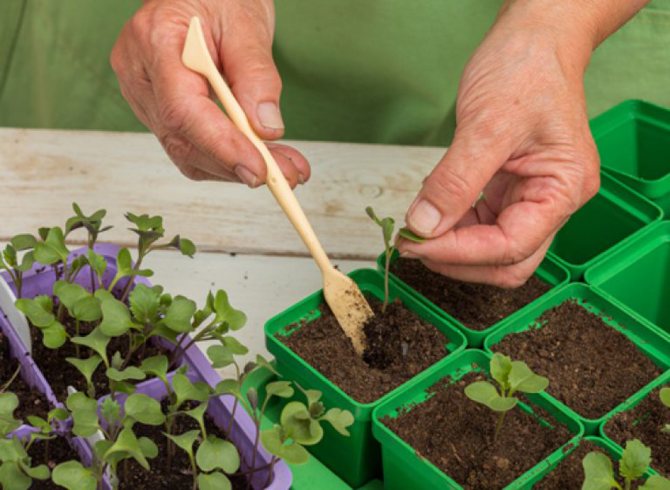

Cauliflower seedlings are dived in a large container so that it develops better
The beds must be prepared in the fall. The water temperature for irrigation should be at least 10 ° C, watering is done at the root. If the air temperature has exceeded 18 ° C, it is better to switch to sprinkling.
Siberia
Short summers and low temperatures require careful selection of varieties. It is necessary to dwell on those that ripen quickly and are not afraid of cold weather. Grow well in Siberia outdoors:
- Snow globe - resistant to diseases and bad weather conditions;
- Colored express is one of the most frost-resistant varieties;
- Amphora F1 - early maturing, head weight up to 400 g.
They plant in greenhouses:
- Cheddar F1 - has an original (multi-colored) color of the heads ripening period - 65-66 days.
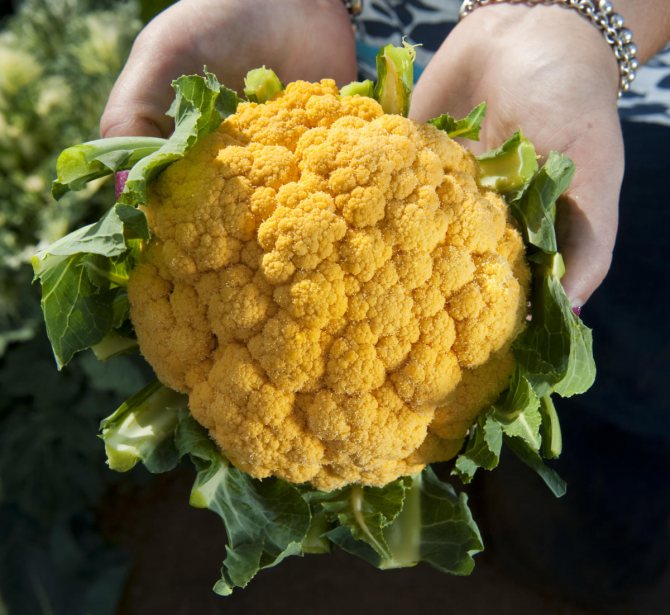

Cheddar heads - different colors on the same bush
Cauliflower in Siberia is grown mainly in seedlings. The most effective option is a cold nursery, which is a wooden box with no bottom. A glazed frame is used as a cover, and the lower open part of the box is placed on the ground. Seeds are planted in late April or early May. After the emergence of shoots, after 40–45 days, the plants are transferred to open ground. The moment of disembarkation is determined by the weather. Seedlings grown at home must be hardened.
Krasnodar region
The best varieties for the Krasnodar Territory are recognized:
- Early Gribovskaya 1355 - this early maturing variety is resistant to hot weather;
- Domestic - ripens 80–117 days after germination, white heads of cabbage up to 900 g in weight tolerate transportation well, can be planted before winter;
- Adler winter 679 - used to get fresh cabbage in early spring. This frost-resistant variety is able to tolerate temperatures down to –7 ° C before head emergence;
- Adler spring - grown in the open field, can be used for winter plantings, which allows you to get a harvest in early spring. She's not very productive, but she ripens faster.
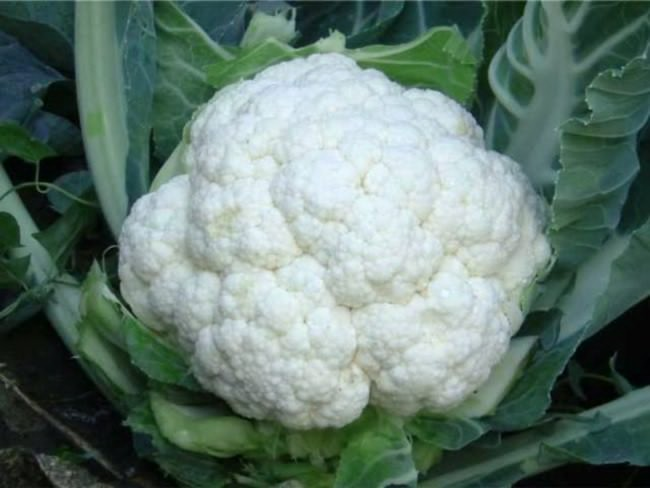

Domestic cauliflower can be planted before winter
Growing seedlings
If you are growing seedlings, then you have to pick the seedlings when they are 8-10 days old. Before the procedure, you should slightly moisten the soil. Remember that excessive moisture in the pots will lead to diseases of the seedlings. Immediately after picking, the seedlings must be fed. It takes about 45-50 days to prepare seedlings. Bushes ready for planting should have at least 5 true leaves and a well-developed root system. Be sure to harden the seedlings, accustom them to the sun, cold and temperature changes. To do this, before planting, seedlings begin to be taken out into the street or left in front of an open balcony. It is advisable to completely identify the plants in the greenhouse for the last few days. If it is cool outside at night, then the film can be left on.
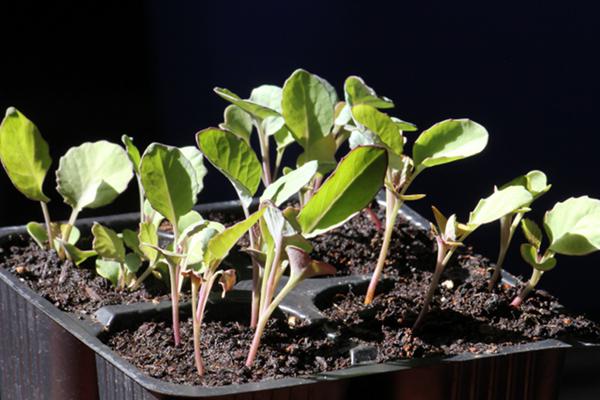

Planting scheme for cauliflower
For planting plants in the ground, choose the evening or morning time. Usually the seedlings are well watered the day before. In dry and hot weather, it does not take root well, so think in advance about how you can shade delicate plants. You can refuse artificial shading only three days after disembarkation. Planting cauliflower outdoors in a specific order, earlier varieties can be planted closer, and later ones farther apart, since they are more bushy. The optimal position is 70 x 40 cm, you should not thicken, as this affects the harvest, you will not get good heads in this case.
However, radishes, dill and lettuce can be used as filler. Due to the fact that these plants ripen quickly and are harvested, they will not harm the main planting. Seedlings of cauliflower are planted so as not to cover the apical bud. The soil around the young plant is well compacted, watered and covered with a layer of soil so that a crust does not form.
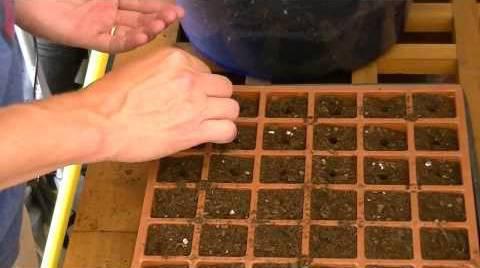

How to water cauliflower - by sprinkling or under the root?
When growing cauliflower, watering is of particular importance. For this culture, both waterlogging of the soil and its aridity are equally undesirable.To determine the need for watering the cabbage, you need to take the soil near the cabbage and try to form a ball out of it. If the ball crumbles from loamy soil, but from sandy loam it does not work at all, then watering is necessary. It also happens that the topsoil is wet, and the cabbage leaves wilted in the heat, which means the roots need watering.
After planting the seedlings, watering is carried out at least 1 time, preferably 2 times a week (about 5-8 liters of water per 1 sq. M) and only at the root... When the plants become strong, it is enough to water them once a week, you can use sprinkling (about 8-12 liters of water per 1 sq. M).
For the whole season, this vegetable should be saturated with water at the root at least three times (10-30 liters of water per 1 sq. M). Such watering is especially important when planting cabbage seedlings and tying a vegetable head.
Cabbage is very fond of watering by sprinkling (especially during the hot period), in which the soil, the plant, and the air are moistened.
Watering is best done in the evening and only with warm water + 18- + 23 degrees, but not higher than +25 and not lower than +12 degrees.
After each watering, the roots must be hilled, and the soil must be loosened.
Seedless growing method: for which regions is it suitable
To begin with, it is worth noting that planting cauliflower in open ground has an undeniable advantage. Overgrown seedlings reduce the yield and deteriorate the quality of products, and so you risk nothing: the plants will develop as it should, in accordance with their biological clock.
Planting cauliflower seeds is best suited for arid, southern regions. But with the advent of early maturing varieties, this method is practiced by all gardeners, up to Siberia. In this case, the root system grows less branched, but penetrates deeper into the soil. Before sowing, markings are made directly on the bed with a distance between rows of 45-60 cm, depending on the characteristics of the variety or hybrid, as well as on the fertility of the soil. When the seedlings produce the first true leaves, thinning is necessary. Leave 15 cm between the plants in a row.When the seedlings release six true leaves, the thinning is repeated, and again there should be an interval of 15 cm between the plants.If the garden is well watered before the mentioned procedure, the pulled out plants retain the root system, and they can be transplanted to another place.
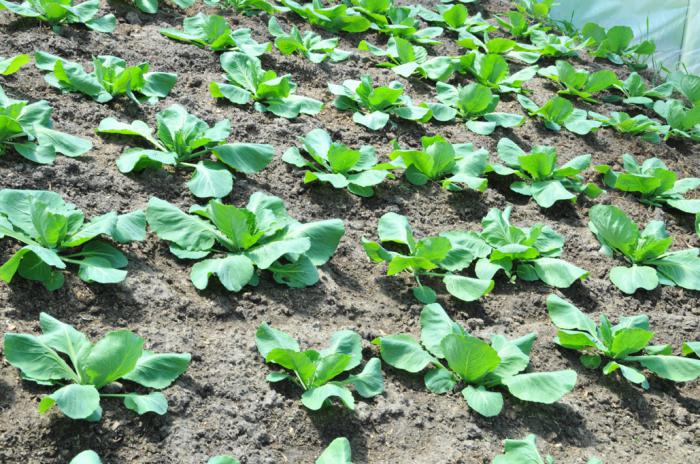

How to plant seedlings in the beds?
In different regions, the transplantation period is selected individually, in addition, the age characteristics of the variety and the condition of the seedlings are taken into account. More resistant and strong seedlings are placed in unheated greenhouses or hotbeds as early as April, providing an additional layer of insulation that protects against frost. And late and weak sprouts are waiting for May.
Important! Late cauliflower varieties can be planted until July 1st.
When planting on the beds, you need to carefully choose the place and composition of the soil, before making all the necessary components. Lack of light and nutrition affects the state of the fruits, they grow small, loose or do not form at all, releasing peduncles.
How to choose a place on the site?
Cauliflower is a light-loving culture that loves the sun, but not the heat. In case of insufficient illumination, the heads are formed small, deformed or not at all, even weak shading affects this.
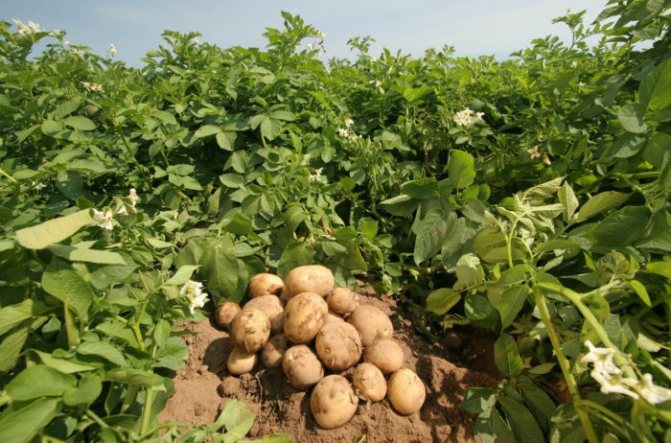

Potatoes in the garden
The best place for growing a crop is loose, nutritious soil, on which non-cruciferous vegetables previously grew: potatoes, tomatoes, onions, melons, grains and cereals. In autumn, the site is dug up and enriched with potassium, phosphorus, humus, leaf humus. During the winter, all components decompose and thoroughly saturate the soil. Before planting, check the acidity of the soil and apply the appropriate preparations.
Planting dates for cauliflower
The procedure begins in warm weather, when there is no longer frost, but the heat has not yet come.In the southern regions, this is done in late April - early May, in the middle lane it is better to focus on mid-May, and in Siberia and the Urals at the end of the month. Planting of late varieties is carried out until July 1, so the early and mid-season varieties are planted first.
To prevent the seedlings from overgrowing and going into arrows, they are planted 45-50 days from the first shoots, but taking into account weather conditions. High-quality planting material should have 4–6 true leaves, a strong stem and hardened health; for this, trays with seedlings are temporarily taken out into the street, gradually increasing the time of walking. 3 days before the transplant, they are left to spend the night in the fresh air, covered with a film.
Soil preparation and seedling planting scheme
Growing cauliflower in the open field is a simple process, but it needs attention and proper agricultural technology. If in the fall the site was dug up and enriched with all the necessary substances, then when transplanting, you will only need to add a handful of special soil:
- Garden land from holes.
- Humus - 1 bucket.
- Wood ash - 500 grams.
- Urea - 15 gr.
- Superphosphate - 2 tablespoons.
All ingredients are thoroughly mixed and added 1-2 generous handfuls to each well.
The culture forms rather spreading bushes, therefore, they adhere to the planting scheme, the distance between the bushes should be at least 30 cm, and the row spacing should be 70–90 cm. Moreover, the interval increases depending on the ripening period, mid-ripening and late ones need more space.
Planting work
Having broken the beds, they start planting cauliflower in the open ground. The procedure is carried out on a cloudy but warm day or in the evening, when the midday sun leaves and the risk of burning the delicate leaves passes.
A prepared composition is introduced into the holes, a depression is made in the middle and the seedlings are transferred by the transfer method so as not to damage the roots. After that, the plants are watered and mulched with peat, sawdust or humus, the embankment should reach the first leaves, but do not close the outlet so that there is no rot.
In the early days, the seedlings should be covered with durable polyethylene at night, protecting them from spring frosts and cold rains, and shaded with paper caps during the day.
Cauliflower: planting and care
Like the closest relatives of the culture, cauliflower is very moisture-loving. The optimum soil moisture should be at least 70 percent, drying out is not allowed. This is especially important during the period of growing seedlings. Even a slight drying out of the soil can lead to the formation of a shallow head or even loss of yield, as it quickly begins to bloom. Compliance with the temperature regime is also very important. Gardeners emphasize that cauliflower is much more capricious than other varieties. Planting and grooming involves constant temperature control. Prolonged decrease in it to + 10 degrees and below leads to a rapid transition to the flowering phase without the formation of a dense head.
Is cabbage afraid of frost
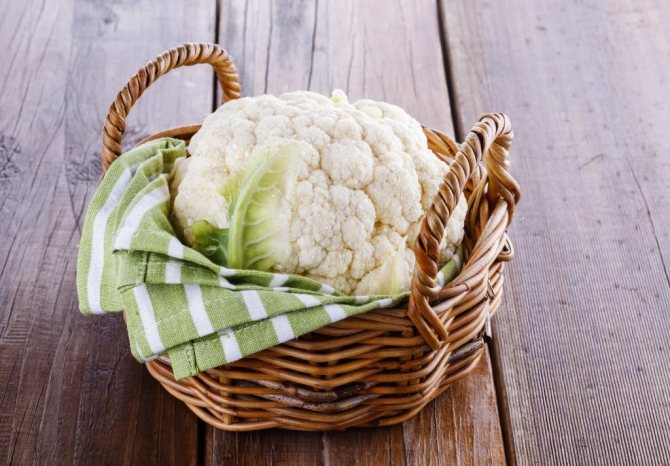

In autumn, a decrease in average daily temperatures to 8 ° C inhibits the formation of heads, but does not spoil their marketability. Spare shoots can form on plants - new, small heads that need to be broken out.
Unlike white cabbage, which gains juiciness during the first frosts, frozen heads of cauliflower lose their presentation and are stored a little. With the threat of a cold snap, the ridge should be covered with spunbond and not delayed with the harvesting of inflorescences. Bushes with small heads should be sent for growing before the first frost.
Food
As already mentioned, cauliflower is more demanding on the nutritional value of the soil than white cabbage. This should be known even at the stage of growing seedlings. By the way, if you grow it in pots, then sowing can be done in February. Then in June you will already have cauliflower. Planting dates are greatly delayed if you plan to sow seeds directly into the ground.Then you need to wait until the end of April, and then if you have a greenhouse. It is possible to sow in unprotected soil only in May, when the seedlings are not threatened by frost. In the event of a strong drop in temperature, a covering material should be used. Planting cauliflower seeds implies regular feeding, only in this case a good harvest can be expected.
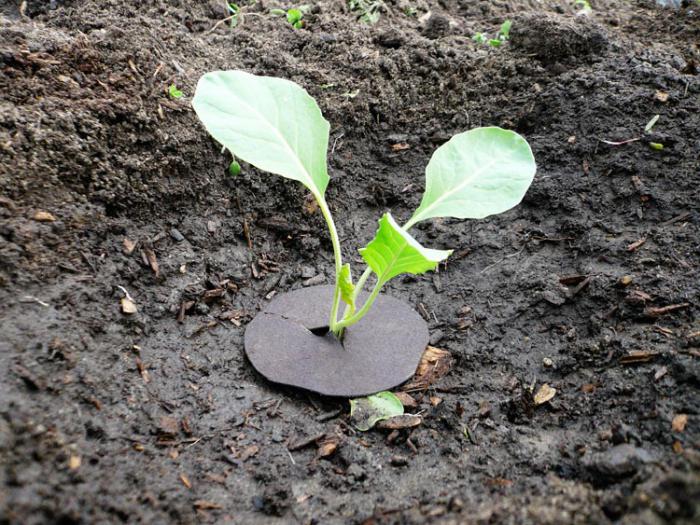

Which cabbage to choose
The variety of cauliflower varieties is amazing. Large and small, low - 15 cm, and high - up to 70 cm, different tastes and colors! From snowy white to cherry and purple.
Photo gallery: variety of cauliflower varieties
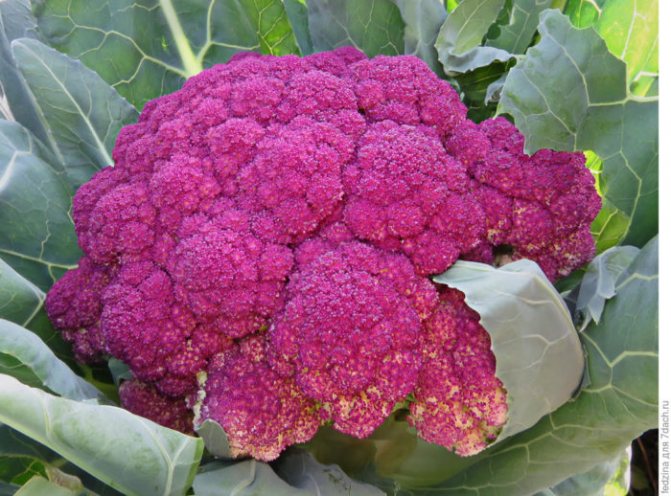

An elegant head of a cauliflower variety Amethyst F1, reminiscent of a bouquet of flowers, will decorate the garden
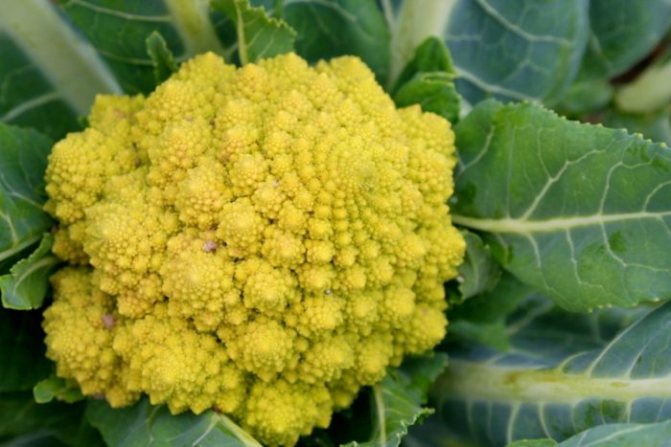

Romanesco cauliflower head looks like an alien from space
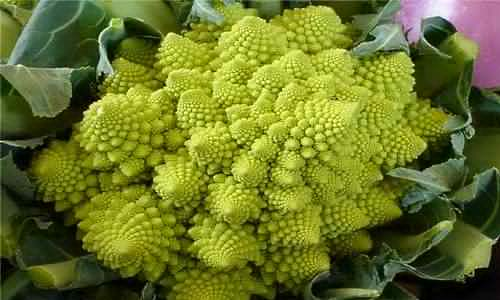

Amphora cauliflower heads have an amazing shape.
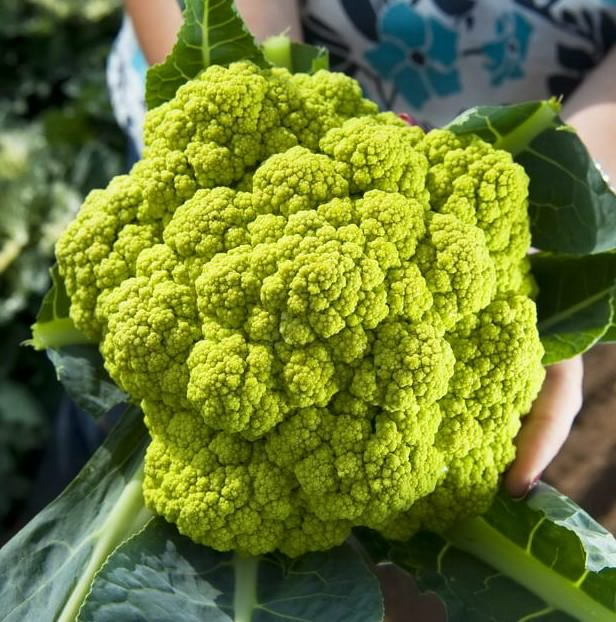

Maserata Green cauliflower tastes like broccoli
When choosing a variety for planting, first of all, you need to estimate the ripening period, since the ability to get a crop on time depends on weather conditions. In the middle lane, it is better to stay with early varieties - they have a better chance of reaching ripeness. The best cauliflower varieties are capable of producing large yields under unfavorable conditions, but it is still better to choose zoned varieties.
When choosing varieties bred for other regions, it is necessary to adjust the planting dates in accordance with the ripening duration. You should also take into account the acidity and type of soil, soil moisture. It must be remembered that good hybrid varieties will yield an excellent harvest, but the seeds obtained from them will not retain the beneficial properties of the “parent”. Hybrids are easy to recognize by the markings on the seed bag - the names end with F1 and you have to buy them before each season. To obtain your own seed, you need to use plants of resistant varieties.
Table: characteristics of cauliflower varieties
| Name | Weight, kg | Ripening time, days |
| Early | ||
| Alpha | 1,2–1,5 | 56–60 |
| Movir 74 | 1,38 | 85–96 |
| Goat-Dereza | 0,7–6,5 | 51–70 |
| Snowball | 0,4–1 | 92–96 |
| Express | 0,35–0,5 | 55–60 |
| Medium early, mid late | ||
| Purple | 1,5 | 110–120 |
| White head | 0,8–1,1 | 115–120 |
| Late | ||
| Consist | 0,55–0,82 | 145–170 |
| Autumn giant | 2–2,5 | 200–220 |
Early maturing varieties
Alpha is a very tasty German-bred cabbage. Differs in good productivity. The round, slightly flattened head has a dense, but tender pulp. The yield from 1 m2 reaches 4 kg.
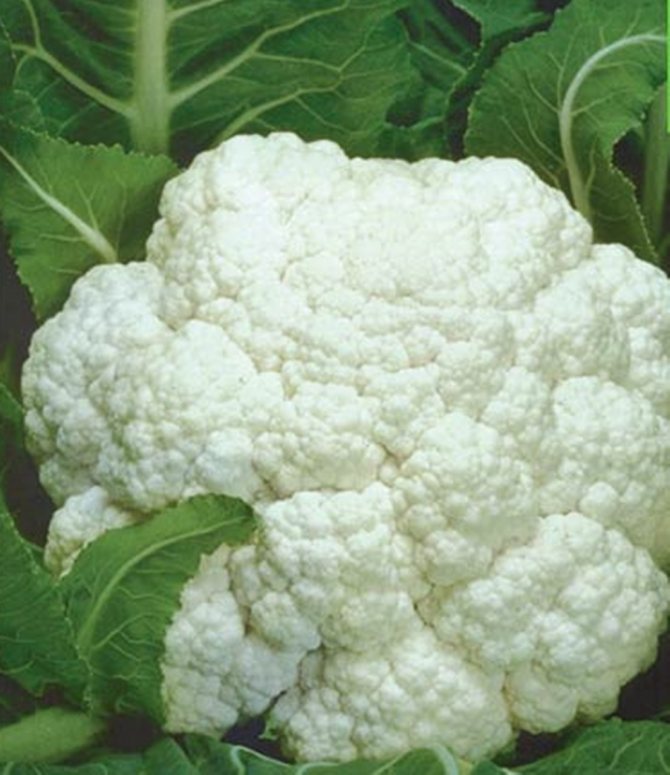

Alpha is a popular but capricious cauliflower variety, picky about the acidity of the soil
The early variety Movir 74 has the same round, white, slightly flattened head. Movir easily tolerates heat and cold, and reacts well to watering. The variety is resistant to cracking, able to resist bacteriosis.
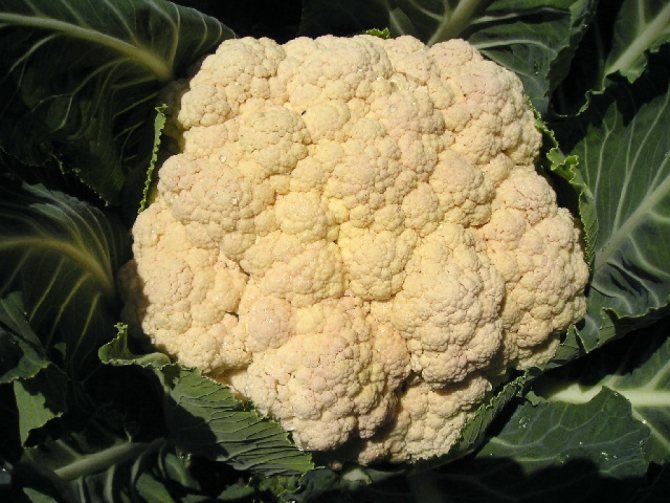

Cauliflower variety Movir-74 - large head has a pleasant taste
The early maturing variety Koza-Dereza was bred. The round head is tuberous, very dense, white. The variety has a high yield (average yield is 3 kg per square meter). The head can weigh up to 6.5 kg.
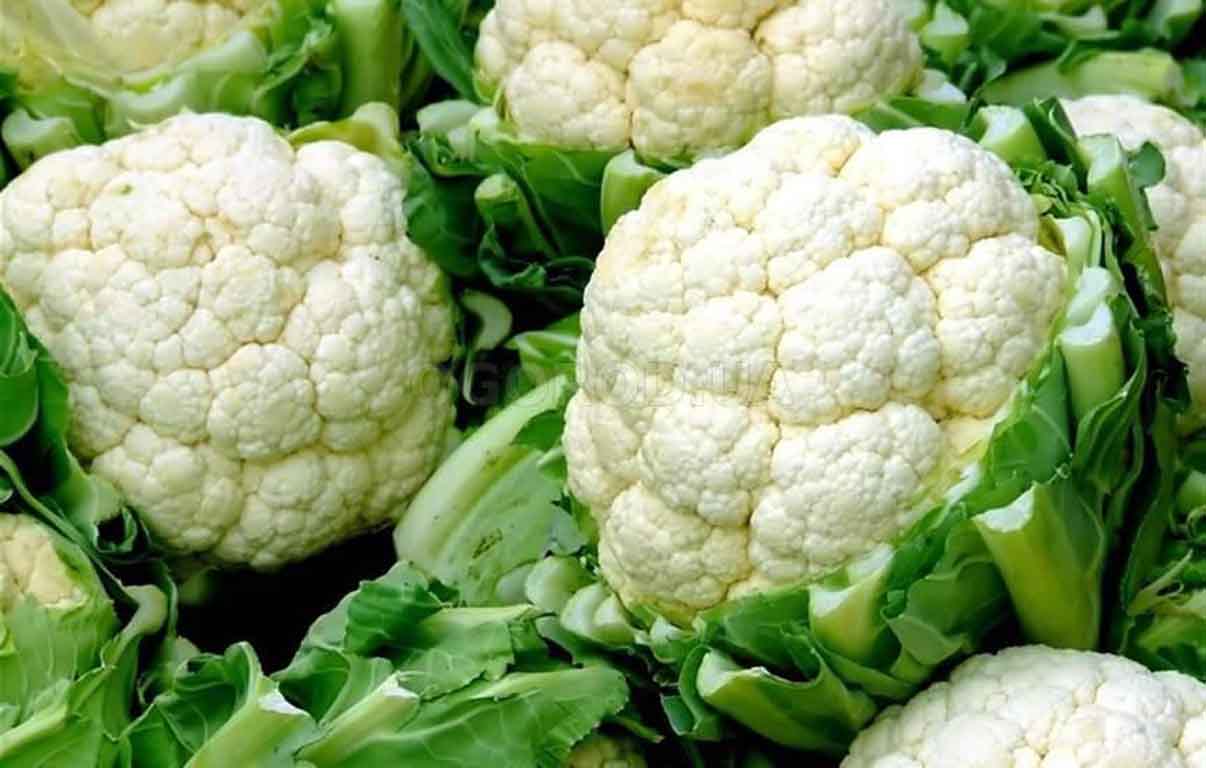

The Koza-Dereza cauliflower variety guarantees a stable harvest
Snowball also belongs to the early ripening, self-closing leaves of which allow the head to maintain a snow-white color. Dense forks are slightly flattened, have high taste.
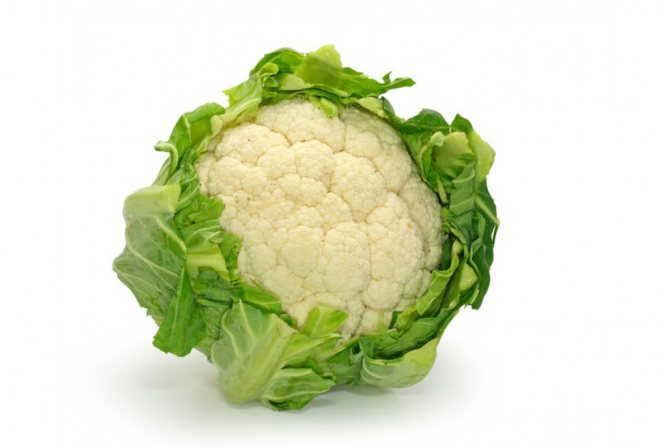

French-bred Snowball cauliflower is distinguished by good germination and amicable ripening
The most delicious of the early varieties is Express. Its small heads ripen quite quickly, the yield is up to 1.5 kg per square meter. Express resists bacteriosis well, but is affected by pests. To preserve the harvest, it is recommended to cover the pre-treated bed.
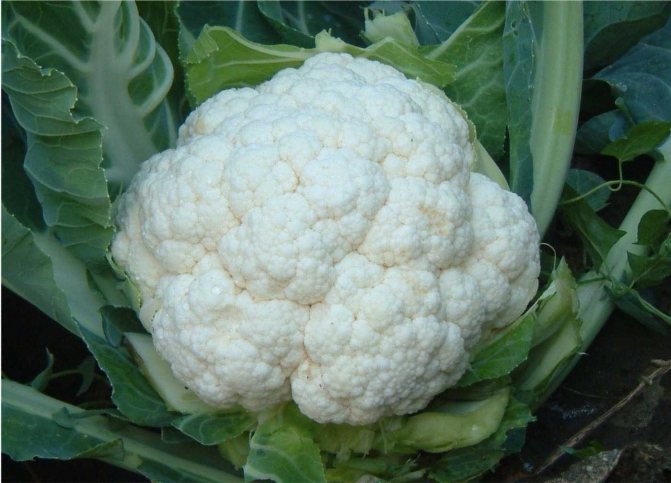

Cauliflower variety Express itself covers the forming head with leaves, does not crack
Mid-early, mid-late varieties
The extraordinary color of Purple cabbage is just one of its advantages. Purple is well stored, disease resistant, and has valuable dietary properties. In addition, she can become a real decoration of the garden.
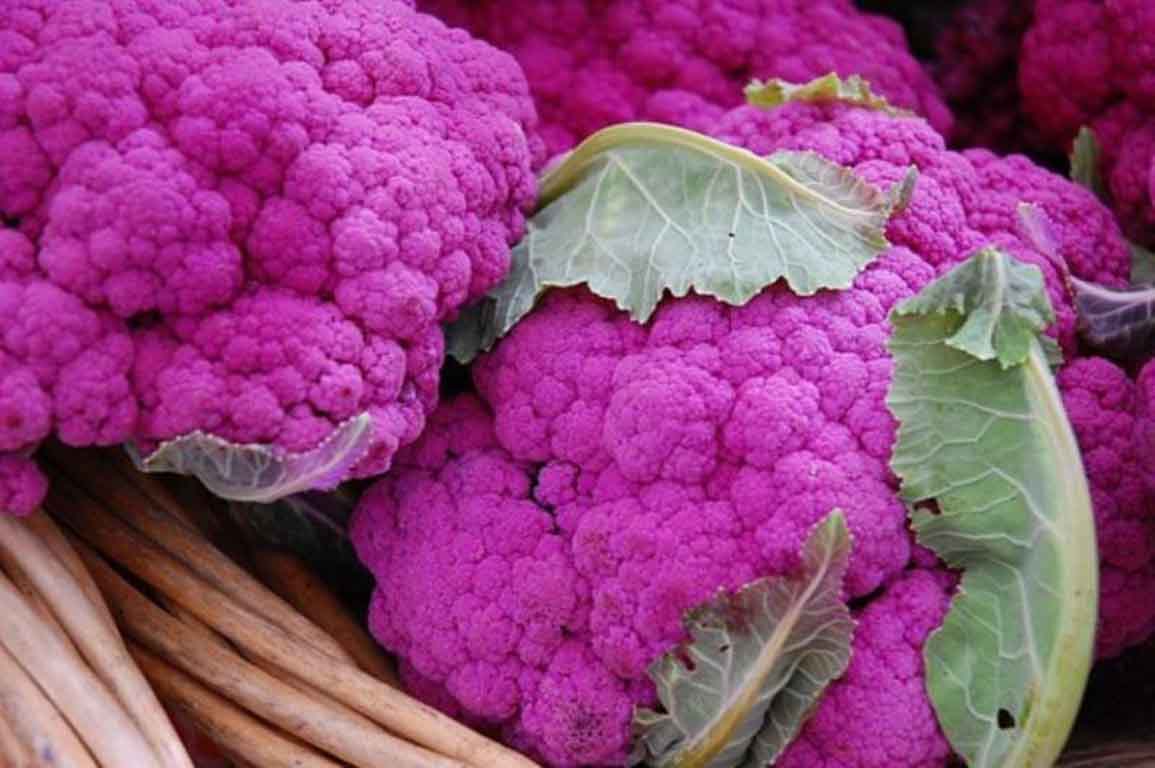

Variety of cauliflower Purple is great for garnishing vegetable side dishes
Variety White head has a whitish, partially covered with leaves, flattened head. The texture of the pulp is medium density, the surface is slightly bumpy. The variety has a good taste.


Cauliflower variety White head has a raised rosette of leaves, which facilitates maintenance
Late varieties
Cultivars that mature later have a longer shelf life. Therefore, in regions where they have time to ripen, the choice of such varieties allows you to use the crop for a long time.
A popular late variety is Consista. The head has a firm consistency, easily tolerates autumn frosts. It is grown on any soil.
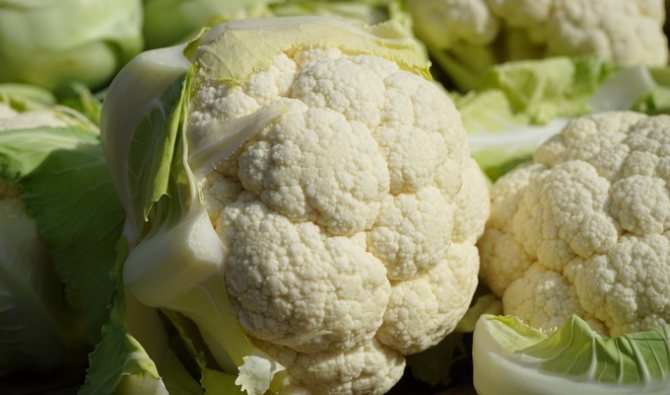

Consista cauliflower withstands adverse climatic conditions
The Autumn Giant ripens even later. Due to the long growing season, it is suitable for planting only in the southern regions. But the size of the head is almost 2 times larger than that of the early maturing Alpha.
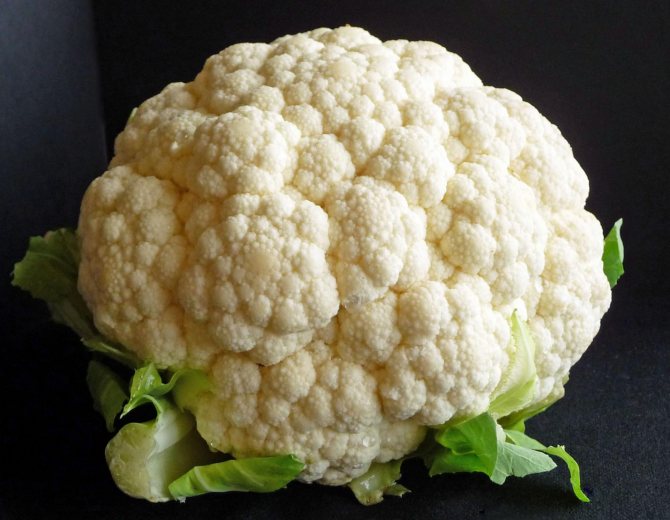

The Autumn Giant variety gives large yields, the head weight reaches 1.5 kg
Second and subsequent feeding
After about two weeks, feeding should be repeated. Planting cauliflower seedlings in open ground is also accompanied by a second fertilization (the first has already been done during the pick). The composition of the nutritional formula may vary depending on the grower's preference. An infusion of mullein or chicken droppings is optimal - 0.5 liters per 10 liters of water. Alternatively, you can purchase any concentrated cow or horse dung extract from the store.
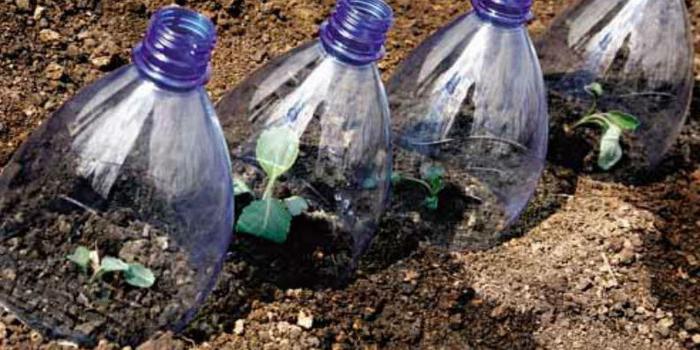

Description of culture, its features and properties
Cauliflower is an annual garden crop grown all over the world. Its roots are fibrous, the leaves are oblong, feathery or lanceolate (depending on the species), the stem is even and dense, the fruits are rounded or flattened heads, consisting of inflorescences.
It is these fleshy inflorescences that are used for food, which, depending on the variety, are painted in white, cream, orange, green or purple. Cabbage pulp is rich in vitamins and minerals, and their content exceeds that of other cabbage vegetables, for which nutritionists respect it so much.
Despite the low calorie content (only 30–35 kcal per 100 g of product), with one serving you can get a daily dose of all the necessary micro and macro elements. Cauliflower contains a full set of vitamins - A, C, B, E, D, U, K, H, PP; and minerals - calcium, potassium, phosphorus, magnesium, manganese, iron, zinc, copper, sulfur, sodium.
Not to mention the other components:
- Cellulose.
- Rapidly digestible proteins.
- Organic acids (citric, malic, tartronic).
- Amino acids.
- Pectin.
- Starch.
- Sugars and carbohydrates.
- Biotin (a rare substance that strengthens the nerves).
All components have a beneficial effect on the work of the whole organism as a whole and on individual systems: digestive, nervous, cardiovascular, immune. Delicate, as if melting in the mouth, the pulp does not irritate the mucous membrane of the stomach, intestines, it is allowed for use by babies during the first feeding period. Cabbage has practically no contraindications and restrictions, it is the leader in the world vegetable market and is second only to the white cabbage variety.
Initially, the culture was recommended for use as a medicine and strengthening the body in winter, but breeders have removed natural bitterness from the pulp and created an ideal dietary product. The benefits for the liver have been proven, the vegetable has a choleretic effect, removes toxins and heavy metals, cleanses the blood, reduces cholesterol production, and strengthens the immune system.
Important! The only case in which it is worth limiting the use of a vegetable is gout.
Diseases and pests
Pests include aphids and cabbage moths. They are disposed of by mechanical assembly or chemical treatment. But remember that cabbage absorbs absolutely everything that gets on it. In early spring, you need to treat the planting with antifungal drugs. Phytobacteria and fungi can severely spoil or completely destroy your crop. Due to the susceptibility of cauliflower to various diseases, many turn out to be from this useful vegetable, but in vain, because high-quality, modern drugs can solve these problems.
Growing and caring for a crop
The technique of planting and caring for cauliflower does not carry anything specific and does not differ much from the cultivation of other cabbage crops. Seedlings need moderate, but frequent watering, top dressing, mulching, loosening of the soil, but all manipulations have limitations and their own nuances.
Violation of agricultural technology is fraught with a poor harvest or even its absence. The key to success lies in loose and nutritious soil, organic and mineral fertilizers.
Proper watering
The surface root system of the crop requires frequent watering and does not like drying out of the soil, this instantly affects the state of the plant. After transplanting, the soil is moistened daily for 1-2 weeks, until the seedlings gain strength and get stronger. Over time, watering is reduced to 2-3 times a week, in extreme heat, the volume of water poured into the holes increases and is maintained with the help of mulch.
Do not allow water to enter the forming heads of cabbage, so it is advisable to use drip or root watering. Sprinkling should be abandoned so as not to lose birth due to rot formed on the stalks and inflorescences of the heads of cabbage.
Weeding and loosening the soil
After each abundant watering, the soil should be loosened, but very carefully, trying not to damage the roots. To prevent this from happening, they do hilling and mulching with rotted leaves, sawdust, small straw or peat.
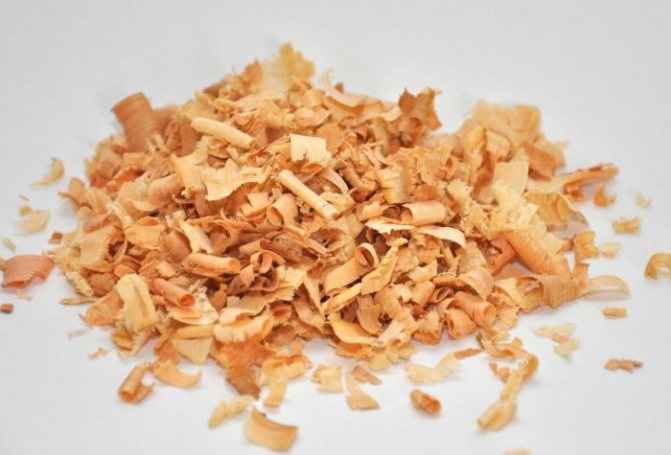

Sawdust
Be sure to monitor the formation of weeds and carefully get rid of them, otherwise there is a risk of infection with diseases or attack by pests.
Plant feeding
For the entire vegetative period, several dressings are carried out. The first is done in the spring, when forming seedlings using mullein solution. Cauliflower reacts sharply to the lack of molybdenum and boron, it is extremely necessary, otherwise the vegetable head will not grow, and the leaves will be narrow and faded.
Saturation with them is possible with the help of mineral solutions, in stores there are special preparations containing all these components. 2 weeks after transplanting to the site, the cabbage is watered with a mullein (1:10), and a week later with minerals, the manipulation is repeated during the formation of the fruit. For the entire vegetative period, the vegetable is fed 2-3 times.
Shading the heads of cabbage from the sun
To prevent flowering and disintegration of the head of cabbage into small parts, experts recommend shading the heads. This is done with the lower leaves, lifting and tying them like a bag around the fruit.
The procedure is carried out on hot summer days to protect the cabbage from damage and burns. They are untied just before the collection or with the onset of cold weather.
Harvesting cauliflower
It begins in July - at this time the early varieties are harvested. The latest ones ripen in August - September. When harvesting, one must be guided by the size and density of the head. In addition, if the head turns white, this also indicates its ripeness. Most often, as soon as the forks reach a diameter of 8 cm, it is time to cut it off. Overripe is bad for the taste. If the head begins to crumble, this is also a signal for immediate cutting. Cabbage can be pickled and will keep in the refrigerator for a long time as a ready-made cold snack. This tasty and healthy dish will provide the body with vitamins and pleasantly diversify the menu.
Collection and storage
Harvest the cauliflower as it ripens, choosing ready-to-eat heads.
- Cut off the head so that 3-4 leaves are preserved on it.
- The harvested cabbage is immediately put into the shade, as it turns yellow when exposed to the sun and loses its beneficial properties.
- Only healthy, intact heads with good leaves are laid for storage.
A head size of 8–12 cm in diameter is considered sufficient. It is not worth delaying the collection, as overgrown cabbage is worse stored.
Late varieties are stored better and longer. Early and mid-early should be eaten right away. To enjoy the harvest for a long time, it is recommended to plant varieties from different ripening groups.
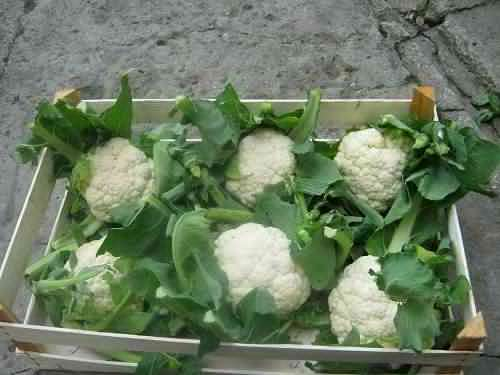

Only healthy, intact heads of cauliflower with good leaves are placed in boxes for storage
You can store cauliflower in different ways:
- at a temperature of 0 ° C in the cellar: the heads are folded into boxes and covered with a film, in this state it can lie for up to 7 weeks. However, boxes should be checked periodically to remove diseased specimens;
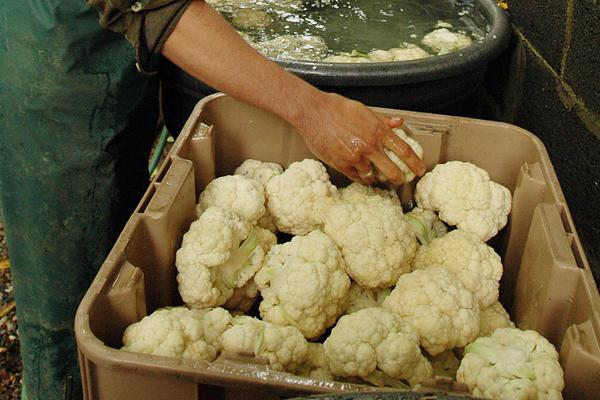

The cauliflower heads in the cellar should be checked periodically
- if you hang the heads by a stump in the same cellar, they will last for 3 weeks;
- you can keep the cauliflower in the refrigerator, with each head being removed in a separate bag;
- disassembled into inflorescences and well-washed cabbage can be frozen; the product is stored in the freezer for up to a year.
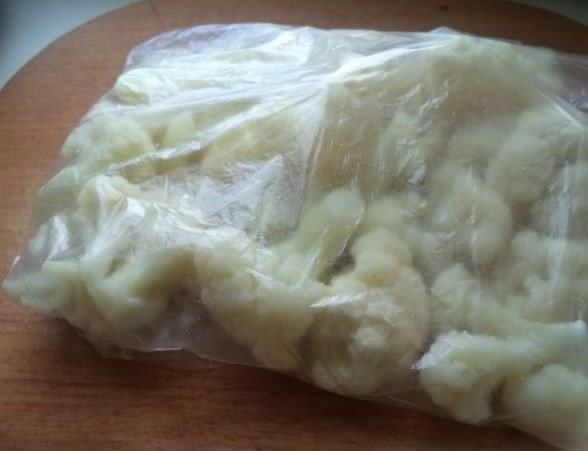

For freezing, each head of cauliflower is cut and folded into a separate bag
If the cabbage is not yet ripe, and the weather has deteriorated, the heads with a diameter of less than 5 cm are grown:
- Plants with small heads are dug from the root, placed in a box, pressing one tightly to the other.
- Fall asleep with earth to the lower leaves. There are 35-40 plants per square meter.
- The box with the cabbage is covered with a dark film, since growing takes place only in the complete absence of light.
- The mature head will reach a weight of 0.5 kg.
Grow room temperature should be 5 ° C.
Completely ripe cabbage can be preserved in the same way. In the dark and covered with earth, it can lie for up to 4 months.
Color caustic hardening
Before planting a plant in open soil, it needs to be hardened at least a week before. For this purpose, the frame is removed in the greenhouse for the day, and subsequently for the night. To increase ventilation, a film covering is removed from the greenhouse a week before planting in the ground. Seedlings should be at least two months old (five or six leaves). Gardeners advise to loosen the soil ten centimeters deep, and then harrow it. For subsequent planting of seedlings, the land is kept clean of grass. If cabbage for seedlings was grown in pots or cassettes, then at the time of planting it does not need watering. In other cases, watering is necessary. It is recommended to plant sprouts of future cabbage in the afternoon. This is due to its excellent rooting at night.
In order for the cabbage to please with significant fruiting, it must be well watered, given the climate of the area where the cabbage is grown. For a plot of one square meter, three buckets of water will be needed. During the growing season, you need to fight parasites and pests, as well as take preventive measures against various diseases. To avoid such a disease as vascular bacteriosis, it is necessary to process the seeds by the method of temperature exposure.
The lowest temperature for cabbage. "Substitute your shoulder"
The main growth of heads of cabbage does not take place in summer, but in September-October. They begin to tie with eight or nine covering leaves. Sometimes inexperienced gardeners remove the top leaves in the fall and ... ruin the "pantry". "Naked" cabbage starts to build up "clothes" in a new way, that is, it spends energy not on what is supposed to be for the season. As a result, for the winter it will be laid "frail", loose, without a hard head of cabbage, as it should.
Instead of “undressing” the cabbage, today is the time to help it grow stronger. For example, it is very important now to loosen the soil around the vegetable. Moreover, this must be done right up to the harvest itself, since then it is easier for the leaf to be filled with carbohydrates and salts. Attention: the more leaves, the more nutrition the plant will receive. In addition, weekly it is necessary to pollinate cabbage with ash on wet leaves (so that it does not crumble), not forgetting about the soil. This is done for the sake of feeding, and against pests, which are also still awake, despite the cool weather.
By the way, about the weather. You should not rush to harvest cabbage. This is the vegetable that sits in the beds for the longest time and is poured, even if it is not May in the yard. Even light frosts are not afraid of cabbage. But if a noticeable "minus" hits at night, then, of course, it will suffer. In this case, there is no need to rush to cut it off early in the morning - let it gradually thaw in the bud. However, a delay in harvesting is also fraught - the heads of cabbage will begin to burst and shoot.
Landing
The root system of this type of cabbage is weak and fibrous. It is located in the upper layers of the soil, that is, cabbage is sensitive to the composition and fertility of the earth. Experienced summer residents advise not to plant a plant in freshly dug ground, so the site for future cauliflower must be dug up three weeks before planting. It's good if the previous vegetables that were grown on the site for future cabbage were cereals, peas, potatoes, carrots. Cauliflower is very demanding on the soil, it does not like acidified soils and grows poorly there. When the soil is acidic, it lacks a very important element - molybdenum (the cabbage just doesn't tie its heads). It is advisable to tackle the decrease in the level of soil acidity in the autumn.
It is better as a soil for seedlings do not use land from a summer cottage, as it may contain unnecessary trace elements and bacteria. The best option would be forest soil, wood ash and sand in equal parts (in the case of sandy soil, the proportion of sand is halved). All this is mixed, spilled with phytosporin and so on for three days. After that, the earth is laid out in prepared cups and poured with diluted water with epin (two drops per two hundred and fifty milliliters). On a plot of one square meter, ten grams of seeds are sown. It should be borne in mind that they need to be placed in the ground at a depth of one centimeter.
When and how to harvest?
On the packaging of the seeds, the dates when you need to harvest the crop are indicated. The gardener needs to be guided by them. In addition, the following signs will tell about the technical ripeness of cauliflower:
- the head diameter is 8-12 cm;
- head weight - from 300 to 1200 g.
In this case, you need to take into account the ripeness of the cauliflower, depending on which variety it belongs to:
- early varieties ripen in 60-100 days;
- medium-ripening varieties can be harvested in 100-135 days;
- late varieties reach ripeness in 4.5 months, so the cauliflower will be on the table until the New Year.
It is not worth delaying the harvest, since the overgrown heads loosen, darken, disintegrate and bloom. So, as they ripen, they need to be cut along with 3-4 rosette leaves 2 cm below the last leaf. Work is best done in the morning, but if frost has begun, you can wait until lunchtime.
If the side shoots have formed in the cabbage, it is worth leaving a few of the strongest ones so that they give new inflorescences.
If the cabbage is intended for storage, you can not cut it, but dig it up with the roots, leaving the outer leaves. Next, it must be laid out in wet sand and transferred to a cool place. In addition, dug heads of cabbage can be hung upside down in a dark, frost-free room.
It happens that late cauliflower, which needs to be harvested before the first frost, does not have time to give out a full-fledged head by this time. In this case, it needs to be grown.This is done as follows:
- Bring a few boxes of garden soil into the cellar.
- Water the planting in the garden, and after 2 days, dig up the heads with a large clod of earth and transfer to the cellar.
- Transplant the cabbage into boxes, immersing them in the ground up to the leaves.
- Regularly moisten the plantings, because cabbage needs at least 90-95% humidity to reach full maturity. At the same time, the room should have an air temperature of 0 to 4ºC and good ventilation.
Nutrients will flow from the leaves to the inflorescences, so in 2 months the underdeveloped heads of cabbage will turn into decent heads that you can enjoy all winter.
How to grow a vegetable to get a good harvest is described in the video below:
Diseases
There are quite a few of them, which is why gardeners often ask the question - why does cauliflower rot (turn yellow, dry out, not grow)? Let's briefly describe the most common problems.
Alternaria
External manifestations are dark spots and concentric circles on the leaves, which die first. The infection is fungal and develops especially rapidly in hot and humid summers. Bordeaux liquid, copper sulfate and other fungicides are effective against alternaria. Prevention - processing of seed material with the composition "Planriz".


Keela
Damages roots, causing ugly growths on them and blocking the transport of nutrients.
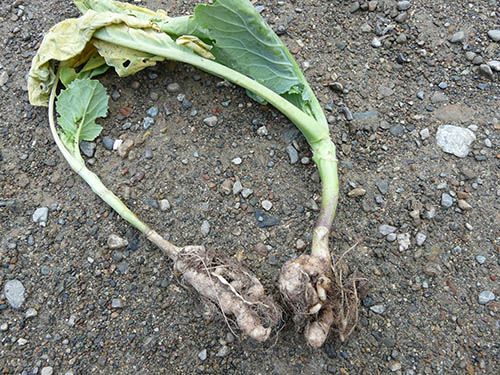

Wood ash and dolomite flour solution will serve as a good "antidote", and "fluff" introduced during planting will serve as a preventive measure.
After infection with a keel, it is impossible to resume the cultivation of cabbage in this area for 5-7 years.
Ring spot
The leaves and stems are covered with growing black dots that transform into rings. This is a fungal disease that leads to yellowing of the leaves and damage to the head. If the treatment with fungicides did not give results, the plants are removed from the site, followed by disinfection.
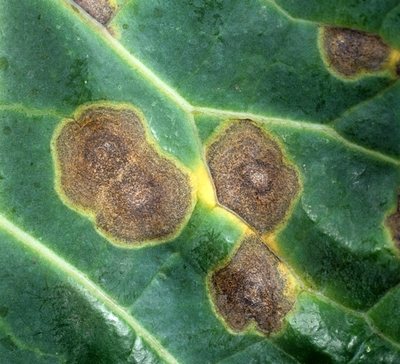

Vascular bacteriosis
It manifests itself in the appearance of spots with progressive leaf necrosis and black fruit rot. The forecast depends on the time when the problem appears - young seedlings will no longer yield a harvest.
Effective drugs are Planriz and Trichodermin.
Vascular bacteriosis more often affects crops with violation of cruciferous crop rotation.
Fusarium (jaundice)
A fungal infection that blocks the vascular system of tissues. The heads are deformed and die without timely assistance. The disease can be treated with the drugs Fundazol and Fitosporin-M.
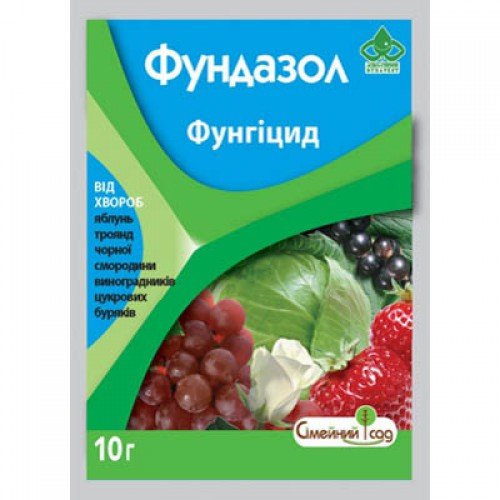

Wet rot
It develops against the background of waterlogging and is expressed by the appearance of black oblong spots that grow, rot and exude a fetid odor. Mechanical damage can provoke illness. If the degree of damage is high, you need to remove what is still edible and dispose of all plant residues.
In addition to the diseases described, the vegetable is susceptible to damage by peronosporosis, black leg and mosaic.
Humidity
In order for the cabbage to fully form and grow, it needs sufficient air humidity (about eighty or ninety percent). Due to the insufficient amount of moisture in the ground, cabbage has an untimely inflorescence formation. Very often, gardeners, in order to bleach the head, break the leaf and put it on top, or, in general, the leaves are lifted and tied. This is not necessary if you are not in a hurry to harvest. If you move the sowing dates to a later time, then without any tying and breaking, when the light intensity is low, you will get a white large high-quality head.
Sowing dates, rules for preparing cauliflower seeds and soil
Before proceeding with the preparatory and sowing work, it is necessary to familiarize yourself with the timing and regional characteristics of sowing cauliflower seeds.
Table: timing of sowing seeds by region
| Region | Sowing dates | Recommended varieties and cultivation features |
| South | Mid - end of April | Any will do.Cauliflower is grown by direct seeding |
| Central regions |
| You can grow any. Seeds of early varieties are allowed to be sown in the ground under a film, starting from mid-May |
| Ural, Siberia |
| Early and mid-season. Seedlings are planted in the ground for at least 50 days. The first 5-7 days after planting, shoots are recommended to be removed under a temporary shelter |
According to the lunar calendar, plants, the fruits of which are formed on the aboveground part, must be sown during the growing moon. And it is recommended to refrain from carrying out sowing work on the new moon and full moon, as well as the day before and after their onset.
Seed pretreatment
Carrying out preliminary measures before sowing will help you choose the highest quality seed and protect future plants from diseases. But before carrying out this procedure, study the packaging: many manufacturers prepare the seeds themselves and indicate the relevant information. In this case, additional processing is not required, you can immediately start sowing.
For all work, try to stock up on soft water not lower than room temperature - thawed, rain, boiled or settled for a day.
Calibration
Calibration of cauliflower seeds is carried out as follows:
- Examine the seeds carefully and select any small and obvious flaws (cracks, holes, etc.).
- Place the remaining seeds in a saline solution (1 tablespoon of salt in 1 liter of water).
- Stir and wait 15-20 minutes. Good seeds should sink to the bottom, and spoiled seeds should rise to the surface.
- Drain the water along with the spoiled seeds, and rinse the rest well in clean water and dry.
If the seeds are medium-sized and approximately the same, then there is no need to sort them by size. In this case, after processing, sow 2 seeds in 1 container, and then remove the least viable shoot.
Disinfection
Procedure for disinfecting seeds:
- Method 1. Prepare a light solution of potassium permanganate (1 g of powder per 200 g of water) and place the seeds in it for 3-5 minutes, and then remove, rinse thoroughly and dry.
- Method 2. Many gardeners find it more effective because it not only disinfects the seeds, but also helps them germinate: Put the seeds in a gauze bag.
- Place the workpiece in a container with hot water (+ 48 ° C ... + 50 ° C) for 15–20 minutes. Please note that this water temperature must be maintained throughout the entire processing time, so place the container on the heater.
- After warming up, immediately place the workpiece in cold (+ 10 ° C ... + 12 ° C) water for 1-2 minutes.
- Remove the seeds from the bag and dry a little.
Soak
Disinfection is carried out as follows:
- Place a piece of cloth (preferably cotton) on the bottom of the plate and place the seeds on it.
- Pour enough water so that the seeds are covered by 2-3 mm.
- Place the workpiece in a warm place for 8 hours. Change the water halfway through. To make soaking more effective, after changing the water, you can add a biostimulant to it (for example, Epin Extra, Energen, etc.), calculating the dosage according to the instructions.
Hardening
Hardening is especially useful for gardeners living in cold areas, as it will help heat-loving cauliflower to better adapt to low temperatures:
- Place a damp piece of cloth on the bottom of a plate and place the seeds on top of it.
- Cover them with a second damp piece of cloth.
- Wrap the workpiece in a plastic bag and put it in the refrigerator on the bottom shelf for a day. Keep the fabric damp at all times.
- After this period, remove the seeds and immediately start sowing.
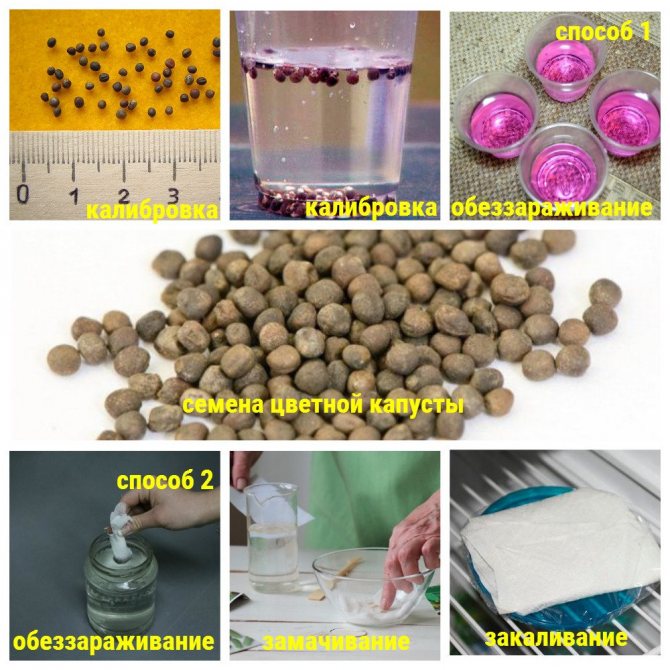

To get high-quality seedlings, the seeds must be processed before sowing.
Soil preparation
For growing cauliflower seedlings, you may well use a universal vegetable soil, but if possible, try to prepare the substrate yourself. The following mixtures are suitable for growing cauliflower:
- garden soil (1 part) + humus (1 part) + peat (1 part);
- peat (3 parts) + rotted sawdust (1 part) + garden soil (1 part);
- peat (3 parts) + humus (1 part);
- humus (10 parts) + sand (1 part) + humus (1 part).
To protect young shoots from diseases, do not forget to disinfect the soil. To do this, place the moistened substrate on a baking sheet covered with paper and heat it for 30 minutes at a temperature of + 70 ° C or spill it with a strong solution of potassium permanganate (3 g of powder per 1 bucket of water).
After disinfection, the substrate must be fertilized. To do this, add ash (5 tbsp. L / 10 l of soil) or a mixture of mineral fertilizers (superphosphate (30 g) + potassium sulfate (15 g) + boric acid (3 g) / 10 l of soil).
Care features
Growing cauliflower outdoors requires proper watering and loosening of the soil, timely and competent feeding and pest control. Useful advice from experts will help you get an excellent harvest.
When and how much to water
The peculiarity of the plant lies in the superficial root system, which reacts to the drying out of the upper soil layer. The condition of the soil should be checked daily. Young bushes are watered at the rate of about 7 liters of water per 1 m2 of land. The volume increases as the bushes grow.
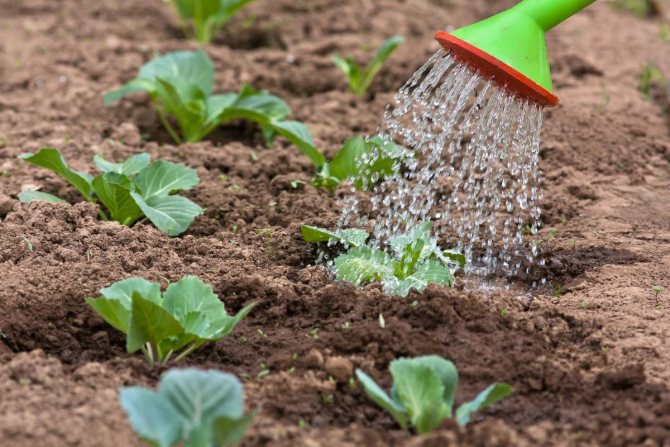

Loosening and hilling
2-3 weeks after planting, the cabbage is spud. After another 10-15 days, the procedure is repeated. During the period of growth of bushes, the soil must be periodically shallowly loosened and mulched with compost or manure.
Shading
Despite the fact that the plant loves the sun, young heads must be shaded, otherwise they will not be dense. For this, several inner sheets are fastened on the crown. Some varieties already have their own leaf shading and do not require additional manipulations.
Top dressing
Caring for cabbage involves feeding. Fertilizers are recommended to be applied in several stages:
- Half a month after planting, ammonium nitrate dissolved in 10 liters of water (1 tsp / m2) is added to the ground.
- After 10-15 days, add superphosphate (10 g / m2) and potassium sulfate (7 g / m2).
- After 2 weeks, complex fertilizers with a minimum nitrogen content are added to the soil.
After fertilizing, the bushes are washed with water to avoid the formation of burns.
Disease and pest control
Young cauliflower is a tasty morsel for parasites and pathogens.
The best plant protection means are adherence to the correct cultivation regime, treatment with biofungicides and decoctions of non-poisonous herbs.
Mucous bacteriosis, black leg, viral mosaic and alternaria are diseases that often affect plants. Systematic spraying with "Fitosporin", "Gamair", "Gaupsin", "Trichodermin", "Binoram" has a positive effect and prevents the development of infection. The main crop pests include snails, slugs, moth caterpillars and white butterflies, aphids, cabbage fly. To combat parasites, bushes are treated with ash or bioinsecticides:
- "Bicol";
- "Verticillin";
- "Bitoxibacillin".
The use of the crop for food is possible only after the expiration of the time after spraying, provided by the manufacturers of chemical control agents.
Features of growing in a greenhouse
Experienced gardeners know how a good yield of cauliflower can be obtained in a greenhouse. They recommend planting seed in greenhouses in May for strong seedlings. It can be used to grow cabbage in a greenhouse.
The main requirements for cultivating vegetables in indoor structures are suitable soil with the necessary fertilizers, sufficient lighting, if necessary artificial, proper watering and regular ventilation.
In autumn, the greenhouse can be used to ripen cabbage when frost occurs. It is necessary to ensure that the temperature inside the greenhouse does not fall below + 5 ° C.
Why cabbage blooms and does not produce a crop
The main reason for the cabbage not being tied is due to the wrong temperature conditions. Heads of cabbage can form at about + 18 ° C. Poor soil, sudden changes in temperature, untimely or too abundant fertilization can also lead to the absence of ovaries after flowering. What if the cabbage does not yield a harvest? Eliminate the above causes, prevent plant diseases and carefully monitor soil moisture.
How to grow seedlings?
Growing strong seedlings is essential for a good harvest. This process can be divided into several stages, each of which requires special attention.
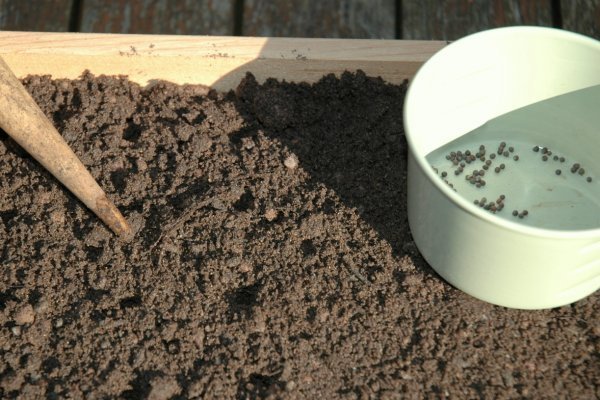

Substrate preparation
You can buy it in the store or prepare it yourself, but in advance - from the fall. The soil for seedlings should be nutritious, moisture-absorbing, loose and neutral (pH about 6-6.5), since cabbage does not tolerate acidic soils. With this in mind, you can prepare the following compositions:
- low-lying peat, sand and humus - 1: 1: 10;
- low-lying peat, rotted sawdust, mullein - 3-5: 1-1.5: 1.
All types of peat can be used in the preparation of the substrate, since it perfectly absorbs moisture, is breathable and does not compact. When using a low-lying variety, sawdust should be added (up to 1/3 of the composition).
The finished substrate must be steamed for 2 hours, and then nitrogen fertilizers are applied. Popular options include:
- urea or ammonium nitrate - 20-25 g;
- complex fertilizers - 50 g per 1 liter.
In addition, 300-450 g of dolomite flour can be added to 10 liters of high-moor peat. If there are no trace elements in the top dressing, you should additionally add 1 glass of wood ash, since this is an organic source of potassium, which also lowers the acidity of the soil and increases the concentration of phosphorus, boron and manganese in it.
Store the prepared substrate until spring in a place protected from rodents.
Seed treatment
For sowing, it is better to choose only large and heavy seeds. They need to be subjected to the following processing:
- For disinfection, soak dry seeds for 15-20 minutes in hot water (+ 45 ... + 50 ° С). This will help destroy viruses on their surface, which can continue their vital activity in the soil and provoke various diseases in a growing culture. Soaking can be done in a thermos.
- After soaking, immediately cool the seeds in cold water and dry.
- For a day, soak the seed in a solution of mineral fertilizer, otherwise, after scalding, they will not be able to release the flower arrow. For example, for pecking and germination, seeds can be soaked in a solution of Nitrofoski (1 teaspoon per 1 liter of water). Untreated material can be simply soaked in Fitosporin solution to obtain a double effect - to treat diseases and organize the necessary mineral feeding.
- When the seeds are baked, harden them. To do this, they need to be moved to a cool place for a day, where the temperature is kept at + 2 ... + 5 ° С. For example, they can be laid out on the bottom shelf of the refrigerator. Next, you need to get the seeds, keep them warm for a day and put them back in the refrigerator for a day.
Properly treated seeds will produce strong seedlings that will tolerate adverse conditions more resiliently.
Sowing seeds
At the optimal time, they can be sown for seedlings, adhering to the following order:
- Prepare containers for growing seedlings.The best option is peat pots or plastic cups with a diameter of at least 6 cm, since in this case there is no need to pick the plant. As a last resort, you can use a deep box.
Cauliflower does not like picking, because it is a lot of stress for it, which can lead to a delay in development for 1-1.5 weeks.
- Pierce the substrate in the oven for 5 minutes. Acceptable temperature is 60-80 ° С. Thanks to this technique, the soil will be cleared of pathogenic microflora, which will increase the disease resistance of future seedlings.
- Place drainage at the bottom of the prepared container, and then fill in the substrate.
- On the soil surface, make small depressions 0.5 cm deep, throw 2-3 seeds into each of them, compact the soil and mulch with a thin layer of sand. If planting is carried out in a common box, then the seeds should not be placed too densely, otherwise, when transplanting seedlings to a permanent place, their roots can be damaged. So, sowing should be done in rows, making furrows at a distance of 3 cm from each other and spreading the seeds at intervals of 1 cm.
- To preserve soil moisture, cover the crops with a transparent film.
How to plant seeds in cassettes so as not to carry out a pick in the future, learn from the video below:
Seedling care
It consists in carrying out such agrotechnical measures:
- Organization of optimal temperature conditions. Before the appearance of the first shoots, the temperature should be maintained in the range of + 18 ... + 20 ° С. When shoots appear (usually 7-10 days after sowing), remove the protective cover and rearrange the seedlings closer to the light source, and lower the temperature to + 6 ... + 8 ° C, otherwise the seedlings will stretch too much, and the root system will be underdeveloped. After 5-7 days, the temperature regime must be changed again: during the daytime it should be maintained at + 15 ... + 18 ° С, and at night - + 8 ... + 10 ° С.
- Topping. If all the seeds in the hole sprout, you need to leave only the strongest sprout, and pinch the rest at ground level. It is impossible to pull out excess shoots, since this way you can damage the root system of the plant.
- Watering. Seedlings do not tolerate too much moisture and excessive dryness, so it should be watered moderately with settled water at room temperature once a week. To maintain moisture in the soil, it will not be superfluous to mulch it with river sand or vermiculite. It is not necessary to loosen the soil, since the roots of the plant are close to the surface and can be easily injured. After watering, it is worth ventilating the room. Acceptable air humidity is 70-80%.
- Top dressing. Cauliflower is especially demanding on boron and molybdenum, therefore, when 2-3 true leaves appear, the seedlings should be sprayed with a 0.2% solution of boric acid (2 g per 1 liter), and when 3-4 true leaves appear - with a 0.5% solution of molybdenum ammonium (5 g per 10 l of water). A week before transplanting, it is necessary to completely exclude the introduction of nitrogen fertilizers, but 2-3 days before that, the plant can be fed with phosphorus and potassium (2-3 g of superphosphate and 3 g of potassium chloride per 1 liter of water) in order to increase its cold resistance.
- Dive. Cauliflower seedlings do not tolerate picking because they have a very weak and shallow root system. So, from the very beginning, the seeds should be sown in separate cups. However, if they were nevertheless planted in a common box, then with the appearance of 2 real leaves, the seedlings will have to dive. To do this, you need to prepare individual containers deeper so as not to injure the roots when transplanting seedlings into open ground. After picking, keep the seedlings at a temperature of + 21 ° C. When it takes root, then during the day the temperature should be maintained at + 17 ° C, and at night - + 9 ° C.
- Hardening. For 10 days after disembarkation in a permanent place or at the age of 40 days, seedlings with 5 real leaves should be taken out for several hours on a balcony or in a greenhouse, so that it gradually gets used to the open air.
Hardened seedlings can tolerate frosts down to -5 ° C.
Terms of development and ripening of the crop of varieties and hybrids
Among the many varieties of cauliflower, varieties and hybrids are distinguished:
- early ripening - ripen up to 100 days;
- mid-early, mid-ripening and mid-late - ripen in 100-160 days;
- late - most of them ripen in 170 days, some in 230 days.
The table shows some varieties of vegetables and a description of their ripening times after full shoots appear.
| Cultivars or hybrids of culture | The timing of the ripening of vegetables | additional characteristics |
| "Movir 74" - a time-tested variety | Vegetation period up to 115 days | Head weight from 0.5 to 1 kg. Feels great in the garden. The harvest ripens together |
| "Snowball 123" - French variety | The development of a plant from planting to maturation occurs in 75-100 days | Ideal for growing in the Moscow region and the middle lane. Seeds are sown for seedlings in early April |
| “Dachnitsa” is a popular mid-season variety | The growing season is no more than 120 days, extended, which is beneficial for home use | A versatile variety, suitable for cultivation in greenhouses and garden beds. Resistant to cold and heat, has an average yield when grown in beds |
| "Express" is a reliable variety, resistant to diseases and frost | The heads ripen in 100-110 days. | Heads of cabbage are dense, with excellent taste characteristics, used for cooking, preservation and freezing |
| "Fremont F1" - mid-early hybrid, characterized by high yields | Heads of cabbage are formed in 110-120 days | The hybrid is resistant to heat and other stress factors, the plant is powerful, the head is perfectly white, huge - up to 5 kg |
| "Cortez F1" is a mid-season hybrid, its head of cabbage is considered ideal | The heads fully develop in 120 days | The crop is suitable for growing in summer and autumn, but it is highly demanding in its care. Head weight - up to 3 kg |
| “Autumn Giant” is a mid-late variety popular in Russia and Europe | The growing season takes up to 120 days | This cauliflower in the garden can be found when the temperature drops below zero. The plant forms strong heads that perfectly tolerate transportation |
| "Adlerskaya Zimnyaya 679" - a variety bred for cultivation in the Krasnodar Territory | More than 200 days can pass before the technical maturity of cabbage. | The ripening of the crop is stretched out. The heads are not large, but they can withstand small frosts |
What temperature can the cabbage sprouts withstand? Cabbage and frozen
In various regions, the period of possible cold snap can last until mid-June.
Whether cabbage seedlings are afraid of frost, what kind of frosts the cabbage can withstand in spring, and how low temperatures can affect the quality of the crop, depends on which species and variety was chosen for cultivation.
Temperature limits of use
Seedlings of a plant with a seedless growing method die at -3 ° C. If the seedlings were grown in cold greenhouses or were pre-hardened before planting on the garden bed, then they can withstand a short-term temperature drop to -5 ° C, but in this case the total weight and quality of the finished heads of cabbage decreases. If on the street the degree drops below -5 ° C, then the seedlings die.
Causes of freezing cabbage
Consider the reasons for the death of cabbage during frosts. For the development and life of cabbage seedlings in the spring, both frosts and heat are harmful.
If the air temperature drops below 0 ° C, then the water in the plant cells freezes and turns into ice. It is known from the physics course that if water is frozen, then when it freezes, it increases in volume. The same thing happens in plants. When frozen, the liquid tears apart the seedling cells from the inside, and the cabbage dies. Sharp thawing after sunrise is especially dangerous for plants.
You can't let it thaw
The influence of low temperatures can aggravate the wrong choice of planting site, as well as the condition of the seedlings.
Risk areas for cabbage
Plants should not be planted in heavy soils or lowlands. Light loamy areas, well protected from the wind, are suitable for her. In addition to the constant stagnation of moisture in the lowlands, the air during frosts is also 2-3 ° C lower than in flat areas.
For optimal plant development, the soil should not be acidic. On such soils, cabbage will not be able to develop normally, it will hurt, and the fertilizers that you apply will not be able to be completely absorbed by the seedlings. Therefore, if the soil is acidic on the site, then it needs to be limed. For these purposes, dolomite flour is perfect, which will additionally enrich the earth with potassium. In the absence of flour, you can use chalk, ash or lime. Only lime can be used exclusively during autumn digging, so as not to damage the seedlings.
If the acidity index is increased, then the soil is treated with lime
Whether the cabbage is afraid of spring frosts, and how much the seedlings will be affected, also depends on the general condition of the plants. If they are healthy, have managed to strengthen and have grown well, then the seedlings will recover from stress much faster, and the damage to the crop will be minimal.
To grow healthy seedlings, you need to observe the temperature regime. The optimal range is 12-20 ° C. Higher temperatures lead to the fact that the seedlings begin to lag behind in development, they turn out to be weak and not so viable.
It is also necessary to monitor the water regime. Cabbage is a moisture-loving plant, but watering should be such that there is no stagnation of water in the holes. Excess water, as well as its lack, can lead to diseases or death of plants.
Note! Low temperature tolerance of seedlings depends on the type of cabbage.
Subzero temperatures
Frost affects different varieties and varieties of this culture in different ways. Some are able to withstand up to minus 10 degrees, others cannot tolerate even at minus 1, they begin to become fragile, get sick and require urgent rehabilitation. Therefore, it is difficult to give an exact answer whether cabbage is afraid of frost, since it is all individual.
What negative temperature conditions the cabbage can withstand:
- White-headed during development is able to withstand up to 5 degrees of frost. If the temperature is lower, the yield will be much worse. Before harvesting, the formed head of cabbage can hold on well even at minus 10;
- Peking cabbage (seedlings) tolerates temperatures down to minus 2 degrees. A mature (adult) plant can withstand frosts down to minus 5 degrees;
- Cauliflower is not so stable, at any stage of development it is maximally able to withstand up to 2 degrees of frost and no more than 2-4 days;
- Broccoli in the seedling stage of development, if the spring is cold, can tolerate temperatures of minus 2 degrees well. An adult crop plant feels fine at minus 5 degrees.
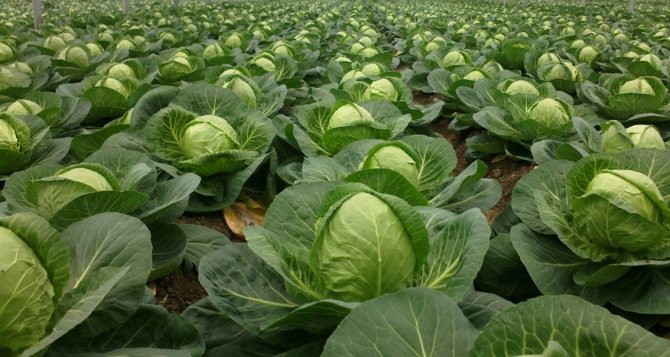

White cabbage
Cabbage, especially white cabbage varieties, tolerates frosts well, so today it can be seen on the plots of gardeners and summer residents in almost all regions of the country, even in the Arctic. What negative temperatures cabbage can withstand at different stages of development is mentioned above.
A phenomenon such as frost does not give pleasure to gardeners during spring planting or before harvesting. How to reduce possible losses, and cabbage to how many degrees withstand frosts in the seedling stage of development, is described in this article.
Requirements for growing conditions
If you decide to grow cauliflower, you need to take into account the basic rules of agricultural technology:
- It is advisable to cultivate a vegetable in a seedling way. Sowing seeds can be done several times at intervals of 10-14 days.To get an early harvest, you need to sow seeds for seedlings from mid-May, and plant them in the ground in early May. For summer use, seeds can be sown in the ground from mid-May, and for late use - from late June to early July. Transplant seedlings to a permanent place at the age of 30-35 days.
In the southern regions of Ukraine and Russia, seeds can be sown directly into the soil, since they can germinate at a temperature of + 2 ... + 5 ° C. In cooler regions, it is better to choose the seedling method.
- Choose loose soils rich in humus with a neutral or slightly acidic reaction for cauliflower. If necessary, lime the site in the fall, and in the spring apply organic fertilizers containing boron, molybdenum and copper, since the plant is especially sensitive to their lack.
- Grow a vegetable at an air temperature of + 15 ... + 18 ° С. If it is under prolonged exposure to low temperatures, this will lead to the formation of small, tasteless heads of cabbage. The increased temperature will also adversely affect their development - at + 25 ° C and above, especially in low humidity conditions, they will stop growing rapidly and become loose.
- Place the culture in sunny areas, protected from cold winds and drafts. Avoid thickened or shaded plantings, since in such conditions the photophilous plant will stretch out and will be more susceptible to various diseases. In addition, shaded heads will grow small, and in full shade they will not tie at all.
With a long daylight hours, the heads will form earlier, but also quickly disintegrate into flowering shoots. In the case of a short daylight hours, they will turn out to be denser and larger, but they will form much later.
If the cabbage is caught in frost. What to do with slightly frozen cabbage
Cabbage is very beneficial for our body. For example, sauerkraut perfectly supports human immunity. Cabbage grows in all vegetable gardens. But sometimes, with the onset of cold weather, not everyone has time to remove the heads of cabbage and it freezes. What to do in this case?
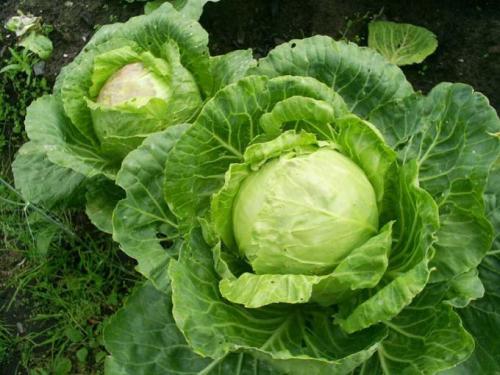

White cabbage is a frost-resistant crop. It can withstand frosts down to -5 degrees. Loose heads of cabbage freeze less than dense ones, because the air accumulating between the leaves serves as a good heat insulator. But even such heads of cabbage do not withstand constant frosts.
If, nevertheless, you did not have time to cut and remove the cabbage for storage in time, and it froze, then it is necessary to determine the depth of freezing. If only the integumentary leaves are frozen, then nothing terrible has happened, and they will restore their basic properties. And if freezing has reached the core, then the head of cabbage can rot.
Frozen heads of cabbage are not suitable for harvesting and pickling. Therefore, you will have to store it only fresh. If the cabbage is frozen on 4-5 leaves, then it can be stored for up to 2 months. But it is necessary to inspect it regularly and store it separately from healthy heads of cabbage. Rotting can come at any time.
You can try to save the most frozen heads of cabbage. To do this, they are kept at a temperature of +4 degrees for 2-3 days, and then transferred to a warmer place with temperatures up to +15 degrees. After thawing, the cabbage should return to its taste. Only storage of such heads of cabbage is undesirable. Therefore, they are simply used for cooking.
And one more thing: vegetables that have been thawed contain a large amount of nitrates, so be careful when using them in food.
Description of cabbage
Cabbage by its origin is a two-year-old plant. In the first year she gives a head of cabbage, and in the second year - seeds. In industry, some farms grow crops to obtain seeds, but gardeners are engaged in cultivation only to obtain a cabbage crop.
Additional Information. Broccoli and cauliflower yield in the form of inflorescences, they differ in that the first is green, the colored one gives a crop of white, pink, yellow inflorescences, similar to a ball. Another popular representative of this culture is kohlrabi. It is not the leaf (cabbage) that is harvested from her, but the root itself. Juicy root heads are used in the preparation of salads, they are even pickled.
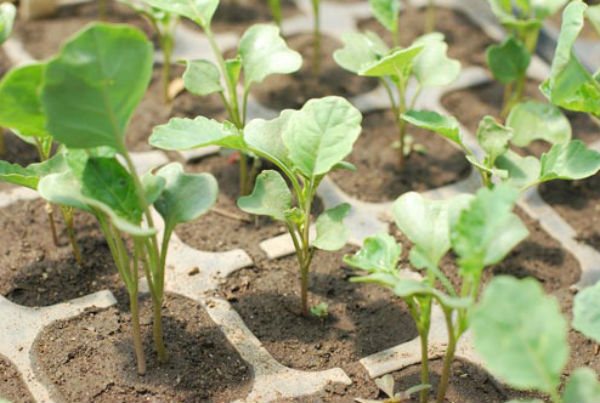

What temperature can the cabbage seedlings withstand?
When to plant?
To harvest throughout the summer-autumn period, seeds for seedlings should be sown 3 times. The exact timing of planting work must be calculated depending on the type of crop:
| Varieties | Planting dates for seedlings | Landing time for a permanent seat |
| Early, hybrid | from 5 to 30 March | in 25-60 days, that is, from April 25 to May 15 |
| Mid late | from April 10 to May 10 | in 35-40 days, that is, from May 20 to June 15 |
| Late | from May 25 to June 10 | in 30-35 days, that is, from 1 to 10 July |
Thus, the seeds of early varieties should be sown for seedlings at the end of February, on average, 40-50 days after transplanting to a permanent place, varieties of an average ripening period - after 2 weeks, and late varieties - after a month.
Garden bed preparation
While the seedlings are growing up, you need to start preparing the site. For cauliflower, it is better to choose fertile soils with a slightly acidic or neutral reaction (pH 6.7-7.4). If the soil is acidic, it must be calcified in the fall by adding lime or dolomite flour during digging. This procedure should be carried out several days after feeding the soil.
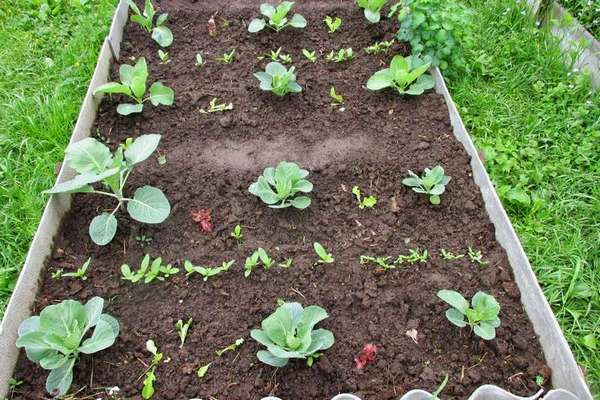

Lime will work faster, but dolomite flour will enrich the soil with not only calcium, but also magnesium.
The best predecessors of culture are:
- roots;
- legumes;
- cereals;
- onion;
- garlic;
- siderates;
- early varieties of cucumber.
Bad predecessors include:
- tomato;
- beets;
- radish;
- radish;
- all types of cabbage.
In an area where bad predecessors used to grow, cauliflower can be grown after an incident for at least 4 years.
Soil preparation involves the following activities:
- In the fall, add organic and mineral complexes, including 150 g of phosphate and 100 g of sulphate or potassium chloride per 1 sq. m.
- In May, the weather is unstable, and cauliflower does not tolerate frost well, so the soil should be insulated in advance. To do this, build tunnel shelters by tightening the beds with plastic wrap, lutrasil or black spunbond to suppress weeds. It is better to choose a non-woven material, since it is good for moisture and air permeability without forming condensation.
The tunnel shelter will allow not only to insulate the ground, but also to protect it from cruciferous flea beetles, which are dangerous for cabbage.
- In early spring, add 1 tbsp for each plant. l. nitrogen fertilizers and up to 1 kg of humus. Some gardeners recommend adding rotted manure or a mixture of humus, peat and compost to the soil at the rate of 10 kg per 1 sq. m.Before planting in the ground, you can also add (per 1 sq. m):
- a bucket of humus or compost;
- 2 cups of wood ash;
- 2 tbsp. l. superphosphate;
- 1 tsp. urea.
The added additives must be thoroughly mixed with fertile soil. It is advisable not to dig the beds, but to loosen superficially, breaking lumps. Large and dense cauliflower heads can only grow in dense soil.
Agrotechnics
It differs little from ordinary cabbage, however, it requires more thorough compliance with the requirements, since the culture is poorly adapted to the climatic conditions of most regions of Russia.
Watering, loosening, weeding
Moisturizing should be regular and sufficient. Under normal weather conditions, it requires watering first twice a week (until the plant is in effect), and then once (taking into account natural precipitation). For 1 sq.m. the beds will first need a little less than 1 bucket of water, but with the growth of the heads, the consumption rate will increase.
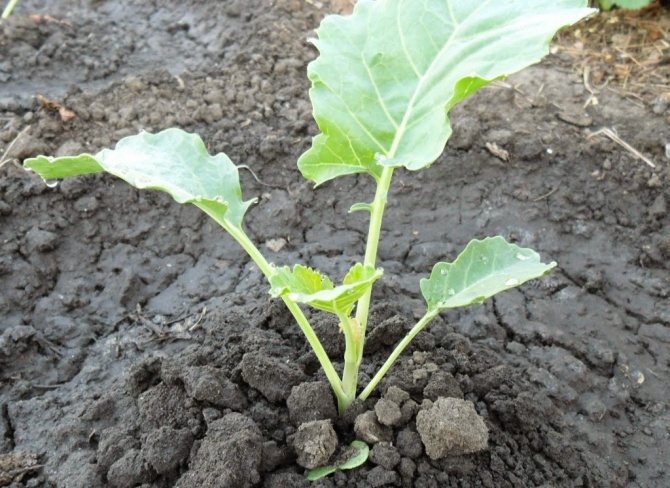

Between waterings, the soil can be loosened superficially, combined with weeding. The least easy and painless removal of weeds is good the day after rain. Watering too often or too much can provoke rotting and the development of fungal infections.
It should be remembered that the vegetable has a very weak and superficial root system, therefore, it is preferable to replace both loosening and weeding with mulching.
Shading
Despite the high requirements for lighting, the heads themselves in direct sunlight tend to become covered with ugly dark spots, loosen and bloom. Therefore, as soon as they began to form, they should be shaded. The leaves of the plant itself are best suited for this. Sometimes they are simply broken up, but this way they quickly deteriorate. It is convenient to use clothespins for this purpose, connecting a couple of sheets above the growing inflorescences.
Top dressing
It will be enough to produce 4 times during the growing season.
1 time
2 weeks after planting in a permanent place (but not later than 3 weeks) using an aqueous solution of poultry manure at a ratio of 1:15. For one seedling - 1 liter jar. Avoid hitting the trunk and the entire aerial part!
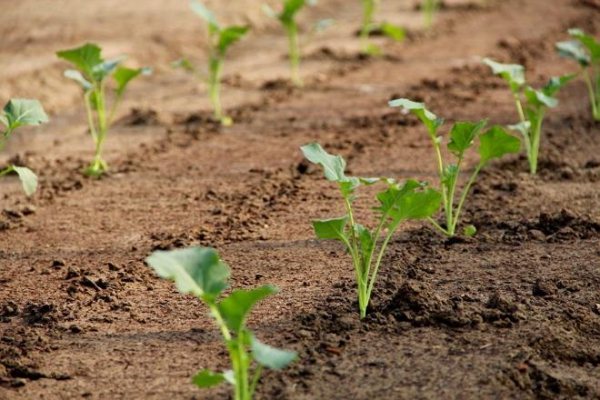

2 times
After another couple of weeks, 10% mullein solution with the same precautions. After 10 days, it can be repeated with the addition of Kristalin according to the instructions.


3 and 4 times
During the period of active formation of heads with a break of 10-14 days. Any mineral complexes are used.
Sowing cabbage for seedlings
Place drainage at the bottom of the pot, then fill in neutral soil. Such soil is sold in stores, but if you wish, you can prepare it yourself: mix 1 part of low-lying peat, 1 part of sand and 10 parts of humus, or 4 parts of low-lying peat, 2 parts of rotten sawdust and 1 part of mullein.
Before sowing seeds, calcine the substrate in the oven for 5 minutes at a temperature of 60-80⁰С (no more!). This will clear the soil from harmful microorganisms and increase the disease resistance of plants.
The seeds are sown in cups or peat pots, deepening by 0.5 cm and compacting the soil, and then mulched with a thin layer of sand.
general description
This cabbage variety got its name for the fleshy flower-stalks, which are usually eaten in the embryonic stage of budding. This annual is mostly familiar to us in white, however, there are much more elegant varieties - from cream to yellow, green and even pink-purple. The root system is located high in the surface layer of the soil.
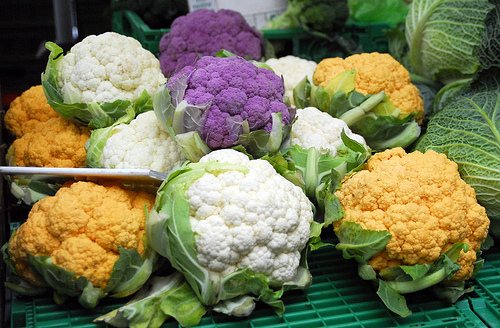

Depending on the variety, from germination to technical ripeness takes from 90 to 120 days. It is grown both by seedling and seedless methods, but in the second case, it will be possible to get a harvest in the exhaust gas much later and only under favorable weather conditions. For example, an abnormally cold and rainy August can nullify all the work.
It is interesting! Under natural conditions, this culture does not grow anywhere. It is believed that it was bred by the Syrians (for which it was called Syrian for a long time), after which it was exported to Spain and Cyprus and quickly spread throughout Europe, and then on both American continents.
Peking cabbage is afraid of frost. Is the vegetable afraid of frost?
When is it better to chop cabbage for the winter: before or after frost? Many varieties of cabbage are frost-resistant, which means they are not afraid of frost. But in order for cabbage to retain its ability to be stored for a long time without losing its freshness, the effect of low temperatures on it during its stay in the garden should be short-lived.
Harvesting cabbage from under the snow at temperatures below -6 degrees negatively affects all varieties of cabbage, as well as repeated freezing after thawing.Thawing, the outer cabbage leaves become a habitat for microscopic organisms that cause crop rot.
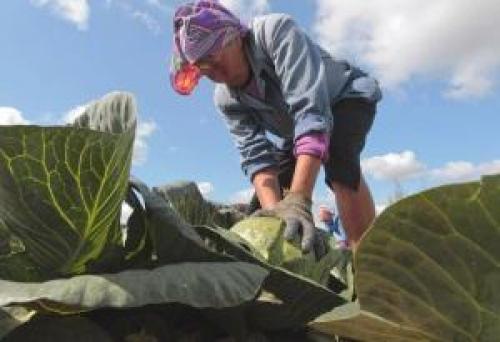

Cut heads of cabbage cannot be left outside at sub-zero temperatures, their long-term storage after that will be impossible.
What frosts can cabbage withstand in autumn? The first jumps in temperature below zero, cabbage, as a rule, tolerates cabbage without problems.
Light freezing even has a positive effect on the taste of this vegetable: a sweetish taste appears.
The maximum minus temperature that cabbage can withstand is minus 6 degrees Celsius, provided that the thermometer does not stay at this mark for a long time.
What kind of frosts can late varieties of cabbage withstand? Late-ripening varieties are also called maturing. In order not to deprive them of their "keeping quality" (long shelf life), they should not be exposed to temperatures below 6 degrees Celsius.
And for cut off late-ripening heads of cabbage, even -1 will be a big tragedy: on the sections, the tissues of the cobs are exposed and freeze very quickly, which subsequently triggers the processes of decay.
Sauerkraut is usually made from heads of cabbage that have been exposed to temperatures as low as -4 degrees Celsius during their growth.
Is Chinese cabbage afraid of frost? Chinese (Peking) cabbage is frost-resistant, but after freezing below -4 degrees Celsius, it begins to rot. It is not recommended to expose Chinese cabbage to temperatures below -2 degrees Celsius. They collect it around October 15, when there is still no permanent frost. You can find out about the ways of storing Chinese cabbage from our article.
Which cabbage tolerates frost well? Frost-resistant cabbage varieties marked F1: Katyusha, Russian Winter, Ulyana. Frosts are also well tolerated by Lika, Yaroslavna, Sugarloaf, Ukrainian Autumn, Zimovka, Amager 611, Snow White, Violanta and Kharkovskaya Zimnyaya.
What if the cabbage is frozen? The heads of cabbage should be thawed without being cut. This usually takes 4 - 5 days, after which the cabbage can be cut and sent for the winter.
Can cabbage be harvested after freezing? Immediately after freezing, cabbage cannot be stored for storage. If you do not wait a few days until the cabbage thaws on the vine, it will start to rot in the first month after harvest: black leaves will appear.
What temperature does Peking cabbage withstand? Biological features of Chinese cabbage
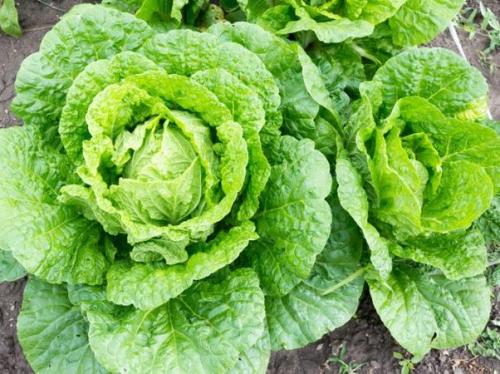

Temperature . Peking cabbage is a cold-resistant plant. Seeds germinate at a temperature of + 2 + 3 ° C for 7-10 days, not evenly. At a temperature of + 18 + 20 ° C, friendly shoots appear already on the 3-4th day. Temperatures above + 25 ° С negatively affect seedlings, they may die. This must be taken into account when sowing seedlings in greenhouses.
Mature Chinese cabbage plants are able to withstand temperatures as low as -4 ° C. Favorable temperature for the development and growth of plants + 15 + 20 ° С. Peking cabbage has one not good feature - at prolonged low temperatures, or vice versa, in too hot weather, it forms a flower shoot, bypassing the head formation phase. Therefore, Chinese cabbage can be sown in 2 stages: 1 - in early spring for seedlings and in the ground in early May, 2 - in the second half of summer in the ground.
Light. Peking cabbage is photophilous, but quite tolerant of shading and gives a good harvest in low light. Peking cabbage is a long day plant, with a day length of more than 12 hours - the plants are shot. This is another reason why Chinese cabbage is sown either in early spring or in the second half of summer. Otherwise, you will have to create a short day for her artificially - covering the cabbage in the evening with dark material and removing it in the morning.
Moisture. For the rapid growth of leaf mass, Peking cabbage requires abundant watering, but it does not tolerate stagnant water.The root system of Peking cabbage has little resistance to decay and keel disease.
The soil . Peking cabbage needs fertile, humus-rich soils. Good predecessors are carrots, potatoes, legumes, onions, green manure, and cucumbers. Cabbage grows very well in the beds in which manure was introduced in the previous year.
When to collect
You need to pick the cauliflower one by one, monitoring the ripening of the head. When the head thickens and turns white it is a sign of ripening. If the heads have already formed completely, then on hot days there is no need to delay the collection. Otherwise, they will begin to loosen. It is necessary to cut off the head with several leaves to protect it from clogging.
To grow cabbage at home, you need to dig it up by the roots and transplant it into a box with earth. Placed in moist soil, sprinkled with earth to the very leaves. As the leaves wither, they are removed. For this method, you need to choose a plant with a lot of leaves. This will make it possible to fill the head with all the nutrients that are in the green mass.
The growing place can be used in a cellar or vegetable store. There must be enough moisture in the room (about ninety percent). The duration of the growing period is influenced by temperature indicators: at thirteen degrees, cabbage ripens in twenty days, at five degrees - in fifty days, and at one degree - in one hundred and twenty days.
Tags: what, cabbage, autumn, grow, temperature, cauliflower
About
«Previous post
Landing in open ground
Approximately a week before the expected date of transfer of seedlings, feeding should be stopped. The only thing that can be beneficial is the introduction of a solution of potassium chloride and superphosphate (3 g each for 1 liter of water). This measure, in combination with hardening the seedlings (taking them to the site with a gradual increase in the term), will help to increase resistance to possible drops in temperature.
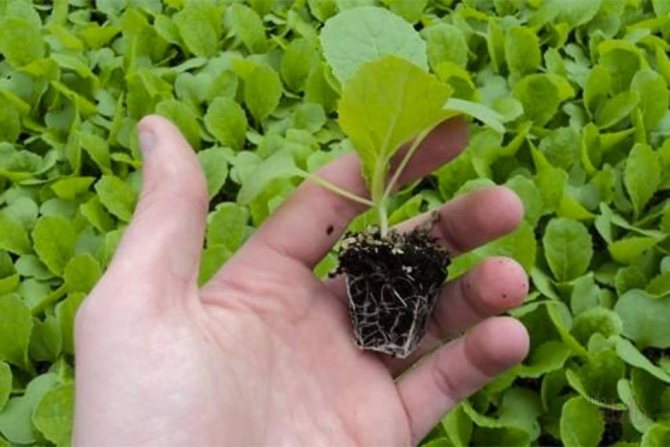

Transplant timing
The planting time for early varieties, sown in late February or early March, begins approximately from April 25 to mid-May, depending on the weather. Mid-season seedlings are planted in the second half of May or even in the first days of summer. The time for late-ripening varieties comes in June, based on the readiness of the seedlings.
Lunar calendar recommendations
All types of cabbage, as crops that bear fruit in the aerial part, are recommended to be planted and replanted during the growing moon.


This is best done in the first quarter of the Moon, excluding New Moon. Landing should not be carried out at the time of the sunset and its rising, it is best if the Moon is generally below the horizon.
It is best to plant cauliflower in the garden on a cloudy but warm day, in the evening.
Site selection, crop rotation requirements
The plot should be located in an open, sunny place. Even a light lace shade will cause the leaves to grow large and the head to form shallow. In a completely shaded area, the heads will not tie at all. Stable winds and drafts are undesirable.
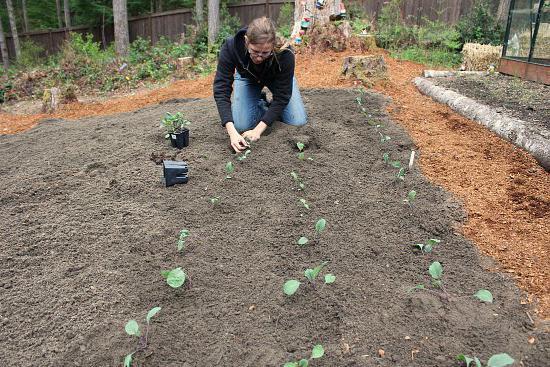

The best predecessors of the cauliflower variety will be potatoes, onions of any kind, garlic, carrots. It is great if in the last season cereals or legumes grew here, which are excellent green manures for crucifers. But in those places where beets, tomatoes, all varieties of radishes and any types of cabbage were grown, this species can be planted no earlier than 4 years later.
Soil requirement and preparation
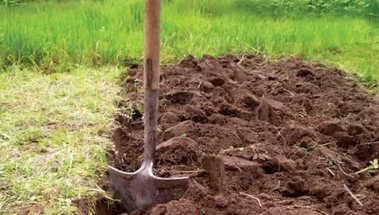

More preferable is the soil with neutral pH values (6.7-7.5). Before transferring seedlings, it is advisable to fertilize it with any mineral complex at the rate of 90-100g per 1 m2. In acidic soils, you can mix "fluff" or another deoxidizer. It was advisable to dig up the plot to the depth of the shovel even in winter (as well as to deacidify it), and in the spring season it was only superficially loosened.Sufficient soil density is an important condition, it should not be too loose, otherwise the heads will turn out the same.
Transplanting
Holes are dug at a distance of 0.3.5-0.5 m from each other. The depth is calculated so that the seedling goes deep into the hole, up to the first true leaves. The deep planting is also the prevention against the cabbage fly. Humus, wood ash are introduced into the hole, you can add 2 tbsp each. superphosphate, mixing well with the earth.
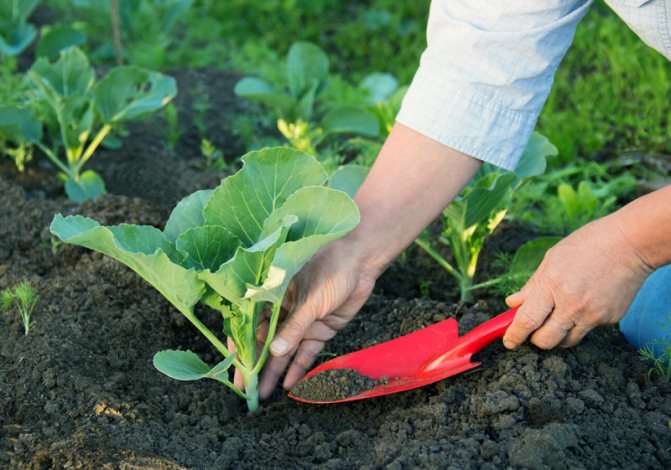

The soil around each seedling is carefully compacted and watered.
An excellent prophylaxis against the bear is the treatment of an earthen coma with karbofos.
Diseases of cauliflower, photos, description and treatment
The following diseases cause significant harm to cauliflower plants:
- Keela... The most common fungal disease affecting the root system, on which growths form. Affected plants wither and die. Diseased plants cannot be treated. They are completely removed from the garden, and the places of growth are treated with 1% Fundazol solution.
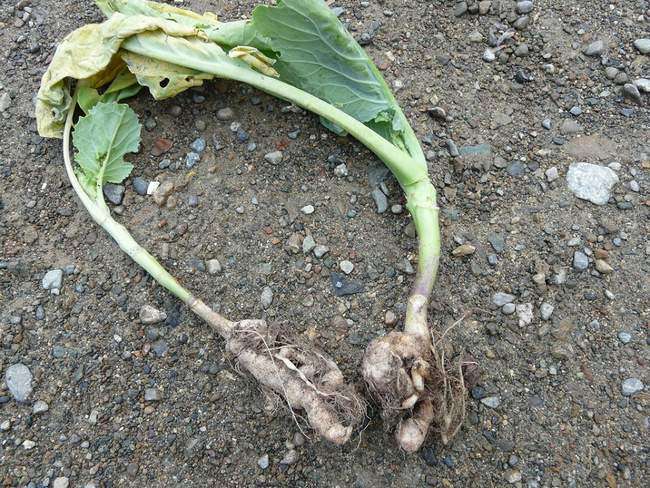

Keela on cabbage roots
- Blackleg... The lower part of the stem is affected, on which darkening of the tissues occurs and their subsequent decay. Control measures: Treatment of seeds before planting with Fundazol.
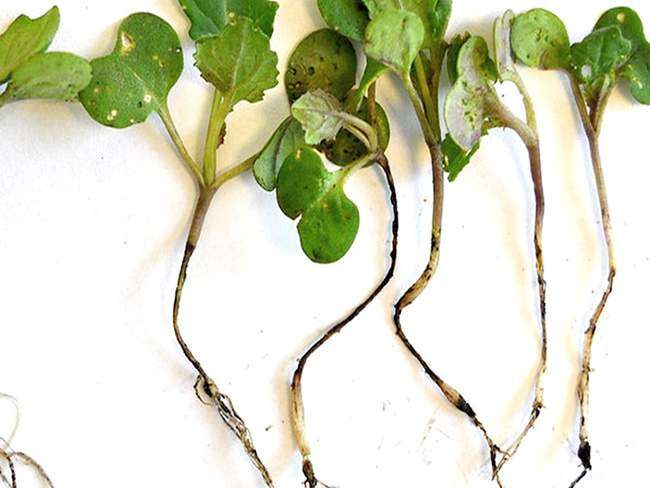

Blackleg is one of the most common cauliflower diseases
- Fusarium wilting... On the affected plants, leaves begin to wilt and fall off. Diseased plants cannot be treated. They must be dug up by the roots and removed from the garden. The place where the plant grew must be treated with copper sulfate (5-7 g per 10 liters of water.)
